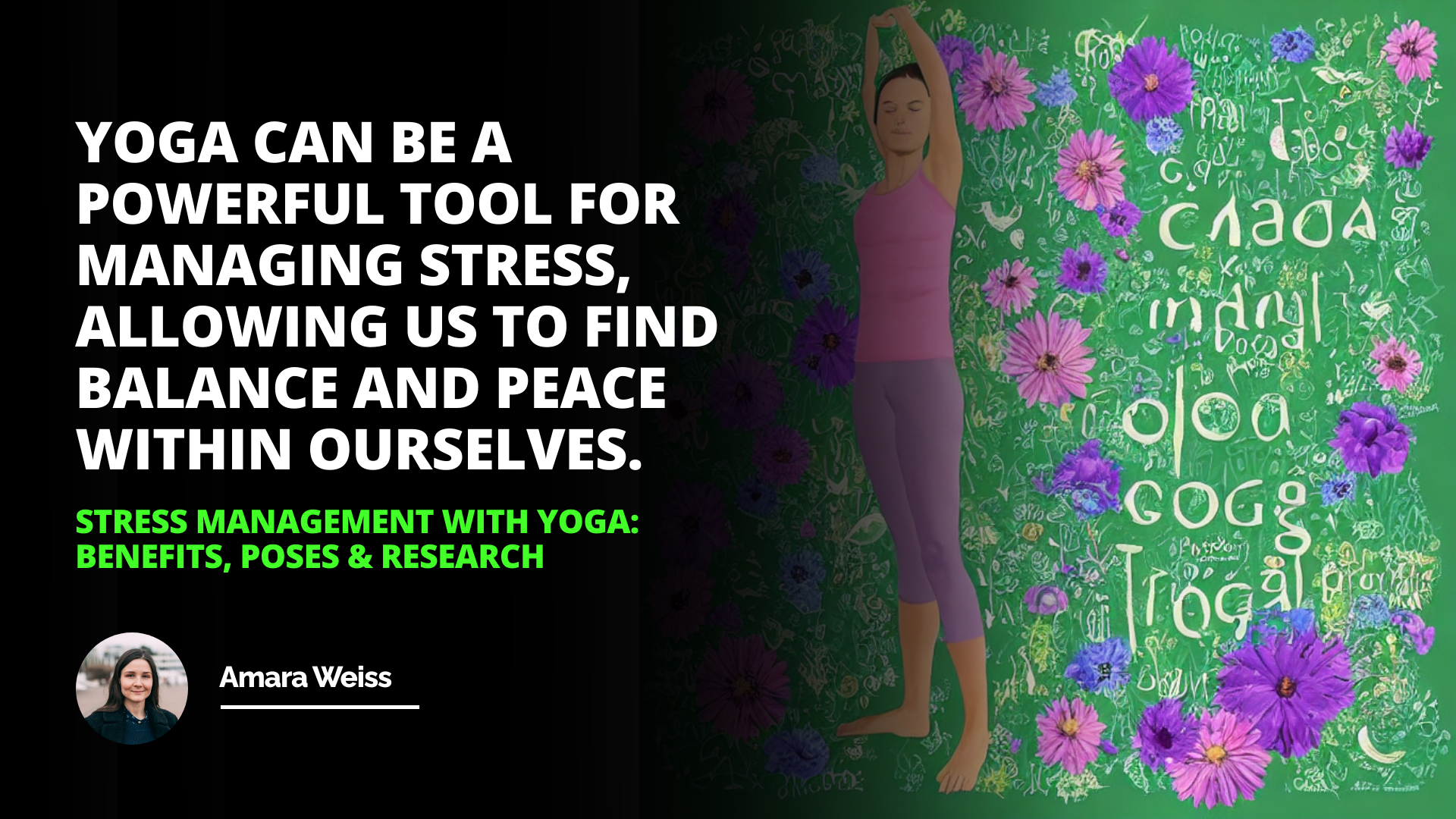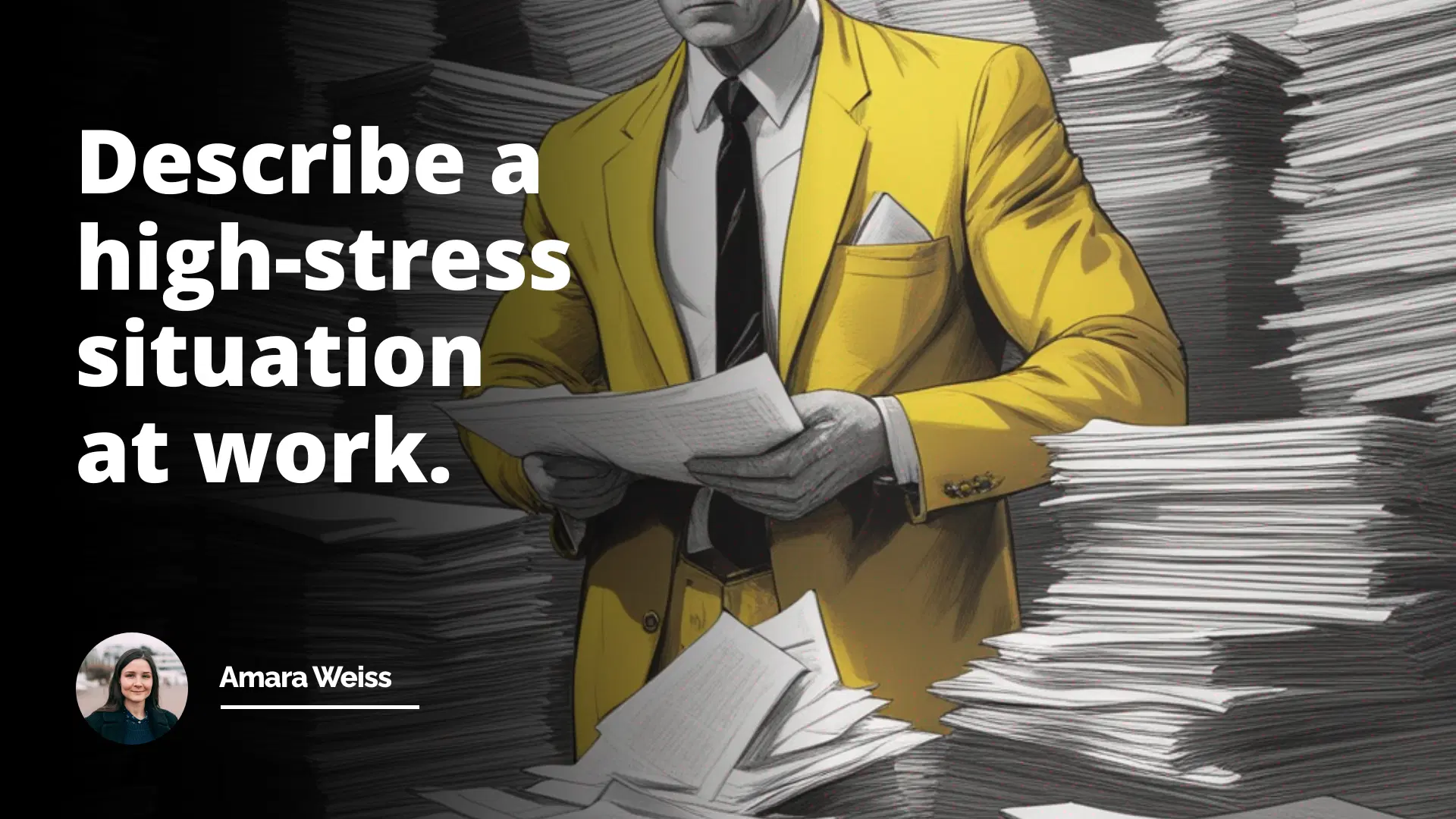
In job interviews, employers often ask candidates to describe a high-stress situation at work to gauge their ability to handle pressure and adversity. This question helps employers assess how well candidates can cope with demanding situations and make sound decisions under stress.
It also provides insight into a candidate's problem-solving skills, communication abilities, and emotional resilience. Employers want to know if candidates can handle the challenges and pressures that come with the job, as well as how they deal with stress and maintain productivity.
The purpose of the question: Describe a High-Stress Situation at Work.
The purpose of asking about a high-stress situation at work is to determine a candidate's ability to handle pressure and adversity effectively. Employers want to assess the candidate's ability to stay calm, make rational decisions, and perform well in challenging situations.
This question also helps them evaluate a candidate's problem-solving skills, interpersonal abilities, and emotional intelligence. Understanding how a candidate has managed high-stress situations in the past can provide valuable insights into their potential performance in similar circumstances in the future.
At what interview level is it asked?
This question can be asked at various interview levels, depending on the nature of the position and the level of responsibility involved. It may be asked in entry-level interviews as a way to assess a candidate's potential under stress.
However, it is more commonly asked in intermediate to senior-level interviews where the role requires strong leadership, decision-making, and problem-solving skills. The higher the level of the position, the more crucial it becomes for the candidate to demonstrate their ability to handle high-stress situations with grace and effectiveness.
Related Course: Leadership Development Course
Interview Question: How Do You Handle Time Management Interruptions?
Interview Question: How Do You Set Time Management Boundaries at Work?
Interview Question: How Does Time Management Influence Your Delegation Choices?
Interview Question: Which Time Management Techniques Help Against Procrastination?
What kind of answer is expected from the candidate?
When answering this question, employers expect candidates to provide a specific example of a high-stress situation they have faced in the workplace. The candidate should describe the situation in detail, including the context, the specific challenges or pressures involved, and the actions they took to address the situation.
It is important for the candidate to showcase their problem-solving abilities, resilience, and ability to manage their emotions effectively. Employers are looking for candidates who can demonstrate their ability to stay calm, think critically, communicate effectively, and make informed decisions under pressure.
Possible answers to consider
Example 1: In my previous job as a project manager, we had a tight deadline and unexpected technical issues arose just a few days before the project delivery. The situation was extremely stressful as it put our client's satisfaction and my team's reputation at risk. However, I remained calm and quickly convened a meeting with the team to assess the problems and brainstorm possible solutions. Through effective collaboration and communication, we prioritized tasks, reallocated resources, and worked overtime to resolve the technical issues and deliver the project on time. It was a challenging experience, but it taught me the importance of adaptability, teamwork, and maintaining a positive attitude under pressure.
Example 2: During a period of significant organizational change, I was assigned to lead a team responsible for implementing new systems and processes. The transition created a lot of uncertainty and resistance among employees, resulting in a high-stress environment. To address this, I organized regular team meetings to openly communicate the changes, address concerns, and provide support to my team members. I also collaborated with other departments to ensure a smooth integration of the new systems. Despite the obstacles, I remained proactive, empathetic, and composed throughout the process. Our team successfully navigated the challenges, and the implementation was completed successfully.
What to consider when answering
When answering this question, it is crucial to choose a high-stress situation that highlights your strengths, problem-solving abilities, and adaptability. Focus on providing a clear and concise description of the situation, emphasizing the actions you took, and the positive outcome or lessons learned from the experience.
Avoid blaming others or dwelling on negative aspects of the situation. Instead, highlight your resilience, effective communication skills, ability to collaborate, and your determination to achieve successful outcomes.
Remember to showcase your ability to stay composed, make rational decisions, and remain solution-oriented in high-stress situations.
Describing a high-stress situation at work is a common interview question aimed at assessing a candidate's ability to handle pressure, make sound decisions, and remain effective in challenging situations.
As a candidate, it is important to provide a specific example, demonstrate problem-solving skills, and highlight your ability to stay calm, communicate effectively, and collaborate with others. By effectively answering this question, you can showcase your resilience and suitability for the role, leaving a lasting impression on the interviewer.
Causes of high-stress situations at work
Effects of high-stress situations on employees
Strategies to manage and mitigate high-stress situations at work
Similar interview questions:
How would you articulate a scenario where you experienced an immense amount of stress in a professional setting?
In what way can you depict a work environment that induced high levels of stress for you?
Can you narrate an incident at work where you found yourself in an extremely stressful situation?
Were there any instances during your employment where you had to deal with an overwhelming amount of stress?
Could you elaborate on an occasion at work when you had to navigate through an exceptionally tense and stressful scenario?
Describe a high-pressure situation you encountered while working, where stress played a significant role.
Recall a moment in your professional life where you were forced to handle a tremendous amount of stress.
How have you managed and coped with a highly demanding and stressful situation at work?
Paint a picture of a work-related episode that pushed you to your limits and resulted in a particularly stressful environment.
Share an example of a stressful event from your professional life and explain the impact it had on you personally and professionally.
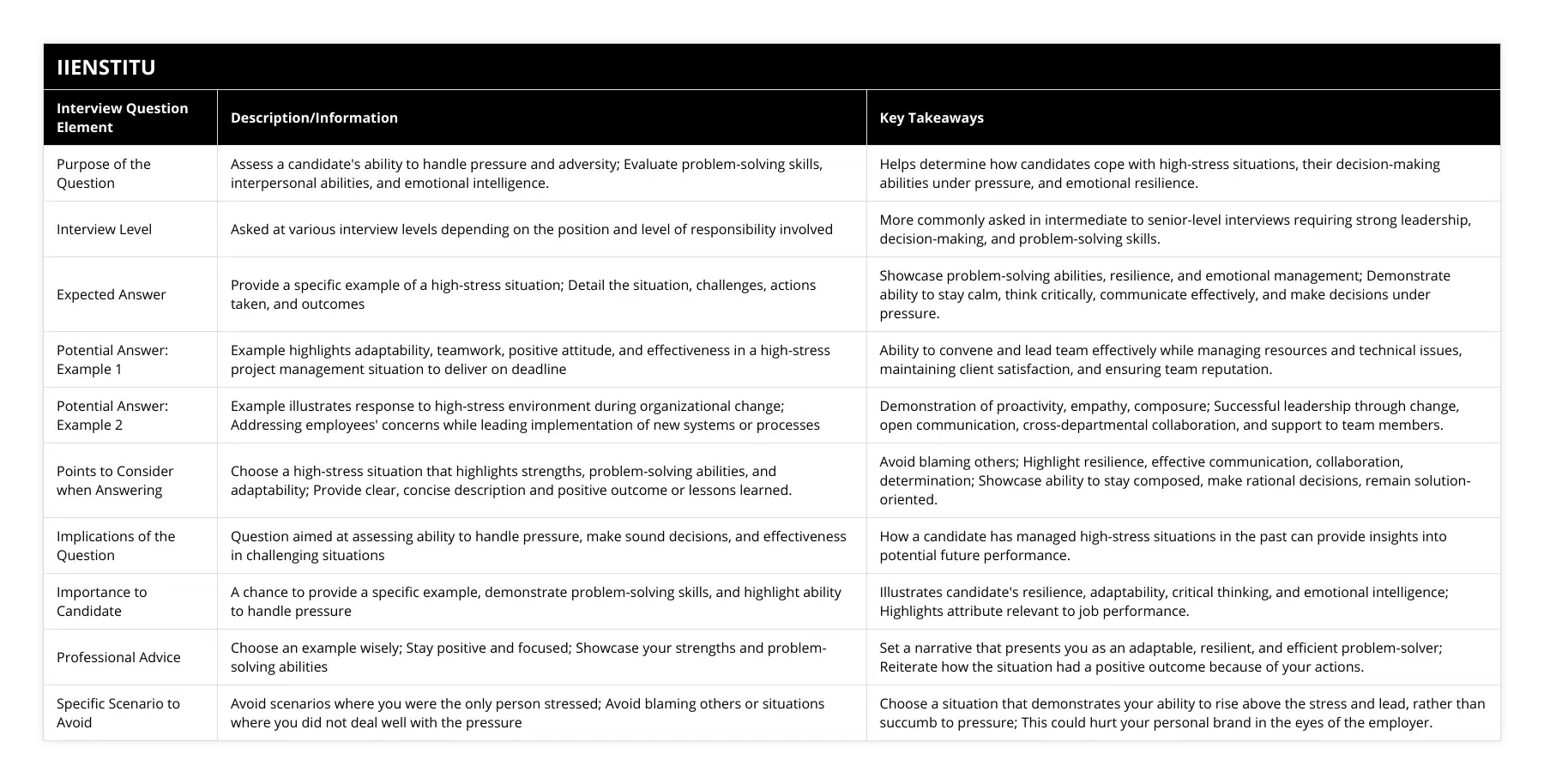
Frequently Asked Questions
How do you typically handle high-pressure situations in the workplace?
In high-pressure situations at work, I prioritize remaining calm and focused on the task at hand. I break down complex problems into manageable steps and delegate tasks when appropriate. Clear communication with my team is crucial to ensure everyone understands their roles and responsibilities. I also take a moment to step back and assess the situation objectively, seeking input from colleagues when needed.
Staying Organized and Prioritizing Tasks
Effective time management is key to handling high-pressure situations. I create a prioritized to-do list and tackle the most critical tasks first. This helps me stay organized and ensures that important deadlines are met. I also set realistic goals and expectations for myself and my team, taking into account any potential obstacles or delays.
Maintaining a Positive Attitude
Maintaining a positive attitude is essential during high-pressure situations. I encourage my team to stay optimistic and focused on finding solutions rather than dwelling on problems. Celebrating small victories along the way helps boost morale and keeps everyone motivated. I also take the time to acknowledge and appreciate my team's hard work and dedication.
Practicing Self-Care and Stress Management
To prevent burnout and maintain peak performance, I prioritize self-care and stress management. I take short breaks throughout the day to recharge and refocus. Engaging in stress-relieving activities, such as deep breathing exercises or brief meditation sessions, helps me stay grounded and centered. I also encourage my team to take care of their physical and mental well-being during high-pressure periods.
Continuously Learning and Adapting
High-pressure situations often present opportunities for growth and learning. I embrace these challenges as chances to develop new skills and strategies. After each high-pressure situation, I take the time to reflect on what worked well and what could be improved. This continuous learning process helps me and my team become better equipped to handle future challenges effectively.
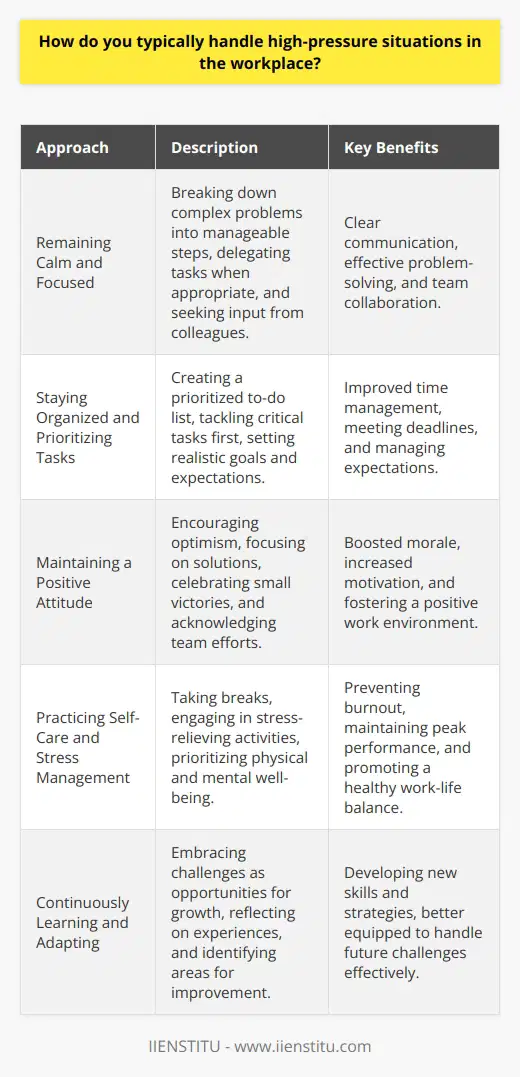
Can you give an example of a time when you had to manage a particularly stressful scenario at work, and how did you approach it?
Managing stress in the workplace is a crucial skill that every professional must possess. One particularly challenging scenario I encountered involved a tight project deadline coinciding with the unexpected absence of a key team member. To approach this situation effectively, I first took a step back to assess the gravity of the problem and its potential impact on the project's success.
Prioritizing Tasks and Delegating Responsibilities
I quickly prioritized the remaining tasks and delegated them among the available team members. This required clear communication and a thorough understanding of each individual's strengths and capacities. By doing so, I ensured that the most critical aspects of the project received immediate attention, while also maintaining a balanced workload for the team.
Fostering Open Communication and Collaboration
Throughout the process, I encouraged open communication and collaboration among team members. Regular check-ins and progress updates helped identify and address any obstacles or concerns promptly. This approach not only kept everyone informed but also fostered a supportive and cohesive work environment, which was essential during this stressful period.
Utilizing Time Management Techniques
To optimize productivity, I employed various time management techniques, such as the Pomodoro Technique and time-blocking. These methods helped me and my team maintain focus, minimize distractions, and ensure efficient use of our limited time resources. By breaking down larger tasks into manageable chunks, we were able to make steady progress towards our goal.
Maintaining a Positive Attitude and Leading by Example
As a leader, I recognized the importance of maintaining a positive attitude during this challenging time. I led by example, demonstrating resilience, adaptability, and a solutions-oriented mindset. By remaining calm and focused, I was able to inspire and motivate my team, even in the face of adversity.
Reflecting and Learning from the Experience
Once the project was successfully completed, I took the time to reflect on the experience and identify key lessons learned. This allowed me to refine my stress management strategies and better prepare for future challenges. By embracing the opportunity for growth and development, I emerged from this stressful scenario with enhanced skills and a greater sense of confidence in my ability to navigate difficult situations.
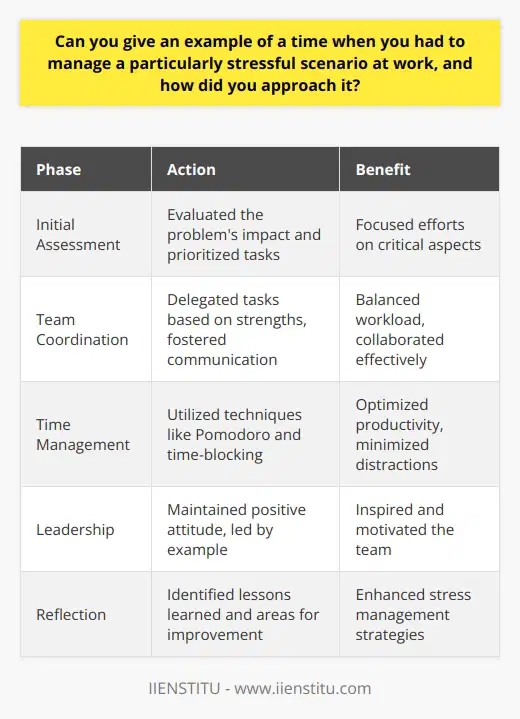
In your experience, what strategies have you found to be most effective for maintaining composure and productivity under high-stress conditions on the job?
Maintaining composure and productivity under high-stress conditions in the workplace requires a combination of effective strategies. One of the most crucial techniques is to prioritize tasks and manage time efficiently. By focusing on the most critical and time-sensitive tasks first, individuals can reduce overall stress levels and ensure that important deadlines are met.
Effective Communication
Another key strategy is to maintain open and clear communication with colleagues and supervisors. Regularly updating team members on progress, challenges, and needs can help alleviate stress and foster a supportive work environment. Additionally, seeking guidance or assistance when necessary can prevent minor issues from escalating into major problems.
Stress Management Techniques
Incorporating stress management techniques into daily routines can also help maintain composure under pressure. Deep breathing exercises, short meditation sessions, or brief walks can provide mental clarity and emotional balance. These practices can be particularly useful during short breaks throughout the workday.
Maintaining a Healthy Work-Life Balance
Establishing and maintaining a healthy work-life balance is another critical aspect of managing stress in the workplace. Setting clear boundaries between work and personal life, such as not checking work emails during off-hours, can help individuals recharge and approach work with renewed energy and focus.
Cultivating Resilience
Cultivating a sense of resilience is also essential for maintaining composure and productivity under high-stress conditions. Embracing challenges as opportunities for growth, learning from setbacks, and maintaining a positive outlook can help individuals navigate difficult situations more effectively. Surrounding oneself with supportive colleagues and engaging in positive self-talk can further bolster resilience.
Adaptability and Flexibility
Adaptability and flexibility are also key strategies for maintaining productivity in high-stress work environments. Being open to change, willing to adjust plans when necessary, and able to think creatively can help individuals overcome obstacles and find alternative solutions to problems.
Self-Care and Well-being
Finally, prioritizing self-care and overall well-being is crucial for maintaining composure and productivity in the long term. Regular exercise, a balanced diet, and sufficient sleep can help individuals manage stress more effectively and maintain physical and mental health. Engaging in hobbies or activities that bring joy and relaxation outside of work can also contribute to overall well-being and stress management.
By implementing a combination of these strategies, individuals can develop the skills and resilience necessary to maintain composure and productivity under high-stress conditions in the workplace. Through effective time management, communication, stress management techniques, work-life balance, resilience, adaptability, and self-care, professionals can navigate challenging situations and achieve success in their careers.

How do you typically handle high-stress situations at work?
Handling high-stress situations at work requires a combination of emotional intelligence, problem-solving skills, and effective communication. When faced with a stressful situation, it's essential to remain calm and assess the problem objectively. Take a step back and identify the root cause of the stress, whether it's a tight deadline, a conflict with a colleague, or a challenging project.
Developing a Plan of Action
Once you've identified the source of the stress, develop a plan of action to address the issue. Break down the problem into smaller, manageable tasks and prioritize them based on urgency and importance. Set realistic goals and timelines for each task, and communicate your plan to your team or supervisor to ensure everyone is on the same page.
Effective Communication
Clear and open communication is crucial in high-stress situations. Keep your team informed about progress, setbacks, and any changes to the plan. Listen actively to your colleagues' concerns and ideas, and be open to feedback. Collaborating with others can help alleviate stress and provide fresh perspectives on the problem.
Managing Emotions
High-stress situations can trigger strong emotions, such as frustration, anxiety, or anger. It's important to recognize and manage these emotions to maintain a professional demeanor. Practice deep breathing, meditation, or other relaxation techniques to help you stay calm and focused. Take short breaks when needed to recharge and avoid burnout.
Seeking Support
Don't hesitate to seek support from your colleagues, supervisor, or HR department when dealing with high-stress situations. They can provide guidance, resources, or assistance to help you manage the situation effectively. Remember, asking for help is a sign of strength, not weakness.
Learning from Experience
After the high-stress situation has been resolved, take time to reflect on the experience. Identify what worked well and what could be improved for future situations. Use this knowledge to develop your stress management skills and enhance your overall performance at work.
Building Resilience
Regularly engaging in stress-reducing activities outside of work can help build resilience and improve your ability to handle high-stress situations. Exercise, hobbies, and spending time with loved ones can provide a healthy balance and reduce overall stress levels.
By developing a proactive approach, communicating effectively, managing emotions, seeking support, and learning from experience, you can successfully navigate high-stress situations at work. Remember, stress is a natural part of any job, but with the right strategies and mindset, you can turn challenges into opportunities for growth and success.
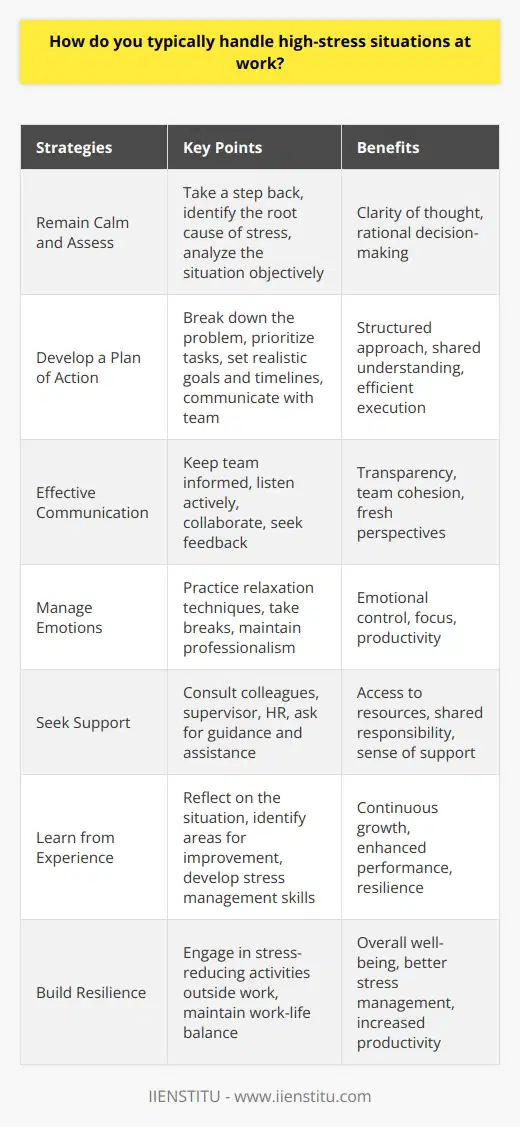
Can you describe a specific instance when you had to deal with a highly stressful situation in your workplace?
One specific instance when I had to deal with a highly stressful situation in my workplace occurred during a critical project deadline. Our team was working tirelessly to complete the project on time, but we encountered unexpected obstacles that threatened to derail our progress. As the project manager, I felt the weight of responsibility on my shoulders to ensure that we met the deadline and delivered a high-quality product to our client.
Identifying the Problem
The first step in dealing with the stressful situation was to identify the root cause of the problem. I quickly gathered the team members and conducted a thorough analysis of the issues we were facing. It became clear that we had underestimated the complexity of certain tasks and had not allocated sufficient resources to address them.
Developing a Plan of Action
Once we had a clear understanding of the problem, I worked with the team to develop a plan of action. We prioritized the remaining tasks based on their importance and dependencies. We also identified areas where we could streamline our processes and eliminate any unnecessary steps to save time.
Communicating with Stakeholders
Throughout the process, I maintained open and transparent communication with all stakeholders, including our client and upper management. I provided regular updates on our progress and any challenges we were facing. This helped to manage expectations and ensure that everyone was on the same page.
Motivating and Supporting the Team
Dealing with a highly stressful situation can take a toll on team morale. As a leader, it was my responsibility to keep the team motivated and focused on the goal. I made sure to acknowledge and appreciate the hard work and dedication of each team member. I also provided support and resources to help them manage their stress levels and maintain a healthy work-life balance.
Implementing Contingency Plans
Despite our best efforts, there was still a risk that we might not meet the deadline. To mitigate this risk, I developed contingency plans in case we encountered any further setbacks. These plans included identifying additional resources we could tap into and exploring alternative solutions to address any remaining challenges.
Leveraging Collaboration and Teamwork
One of the key factors that helped us navigate the stressful situation was the power of collaboration and teamwork. I encouraged team members to work together, share their knowledge and expertise, and support each other. By fostering a strong sense of unity and shared purpose, we were able to overcome the obstacles and push through the challenges.
Reflecting and Learning
After successfully completing the project and meeting the deadline, I took the time to reflect on the experience and identify key learnings. I recognized the importance of proactive risk management, effective communication, and adaptability in dealing with stressful situations. I also made note of areas where we could improve our processes and contingency planning for future projects.
Conclusion
Dealing with a highly stressful situation in the workplace requires a combination of leadership, problem-solving skills, and resilience. By identifying the problem, developing a plan of action, communicating with stakeholders, motivating the team, implementing contingency plans, and leveraging collaboration, I was able to navigate the challenges and deliver a successful outcome. The experience taught me valuable lessons that I continue to apply in my professional life to this day.
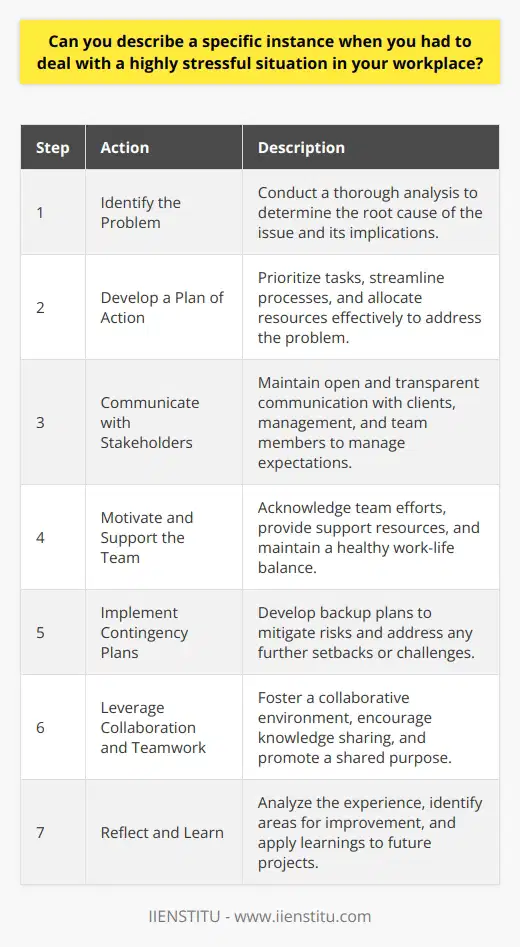
What strategies do you employ to manage and cope with stress in a professional setting?
Managing stress in a professional setting is crucial for maintaining productivity, well-being, and overall job satisfaction. Employing effective strategies to cope with stress can help individuals navigate the challenges of the workplace. One key approach is to prioritize tasks and manage time effectively, ensuring that important responsibilities are addressed while minimizing the feeling of being overwhelmed.
Prioritizing Self-Care
Engaging in regular self-care activities, such as exercise, meditation, or pursuing hobbies, can provide a much-needed break from work-related stress. These activities promote relaxation, improve mental clarity, and boost overall resilience. Additionally, maintaining a healthy work-life balance is essential, as it allows individuals to recharge and approach their professional duties with renewed energy and focus.
Effective Communication and Support
Open and honest communication with colleagues and supervisors can help alleviate stress in the workplace. Discussing concerns, seeking guidance, and collaborating with team members can lead to solutions and a more supportive work environment. Building a strong support network, both within and outside the workplace, provides a valuable resource for managing stress and maintaining emotional well-being.
Mindfulness and Stress-Reduction Techniques
Incorporating mindfulness practices, such as deep breathing exercises or brief meditation sessions, can help individuals stay grounded and focused during stressful situations. These techniques can be easily integrated into the workday, providing a quick and effective way to manage stress in the moment. Other stress-reduction strategies, such as progressive muscle relaxation or visualization, can also be beneficial in promoting a sense of calm and reducing tension.
Continuous Learning and Skill Development
Engaging in continuous learning and skill development can enhance confidence and competence in the workplace. By staying updated with industry trends, attending workshops, or pursuing additional certifications, individuals can feel more equipped to handle the demands of their roles. This sense of mastery and personal growth can contribute to reduced stress levels and increased job satisfaction.
Ultimately, managing stress in a professional setting requires a proactive and multi-faceted approach. By prioritizing self-care, fostering effective communication, utilizing stress-reduction techniques, and investing in personal and professional development, individuals can successfully navigate the challenges of the workplace while maintaining their well-being and achieving their career goals.
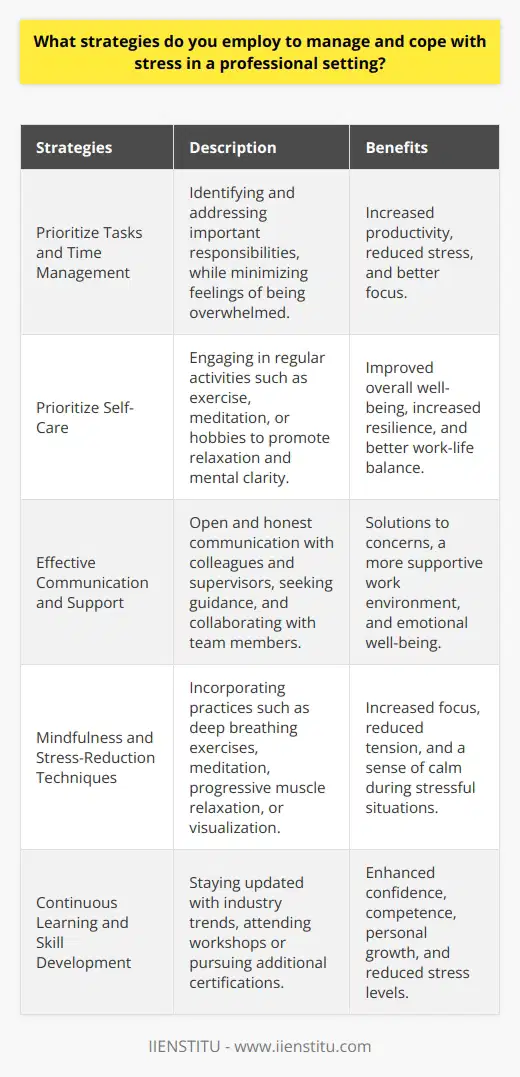
How do you typically handle high-stress situations that arise in the workplace?
In high-stress situations that arise in the workplace, it is essential to maintain a calm and composed demeanor. Taking a deep breath and assessing the situation objectively can help prevent knee-jerk reactions that may exacerbate the problem. It is crucial to prioritize tasks and delegate responsibilities when possible to alleviate the burden on oneself.
Effective Communication
Clear and concise communication is vital when dealing with high-stress situations in the workplace. Ensure that all parties involved understand their roles and responsibilities in resolving the issue at hand. Listen actively to the concerns of colleagues and address them with empathy and professionalism. Maintain open lines of communication to foster a collaborative environment and facilitate problem-solving.
Seek Support
Do not hesitate to seek support from colleagues, supervisors, or HR when facing high-stress situations. Collaborating with others can provide fresh perspectives and help distribute the workload. Reaching out for guidance demonstrates a willingness to learn and adapt, which is essential for personal and professional growth.
Time Management
Effective time management is crucial when dealing with high-stress situations in the workplace. Prioritize tasks based on urgency and importance, and allocate time accordingly. Break down complex problems into smaller, manageable steps to avoid feeling overwhelmed. Utilize tools such as calendars, to-do lists, and project management software to stay organized and on track.
Set Realistic Expectations
When faced with high-stress situations, it is essential to set realistic expectations for oneself and others. Communicate clearly about what can be accomplished within a given timeframe and be honest about any limitations. Overcommitting or making promises that cannot be kept will only add to the stress and strain relationships.
Practice Self-Care
Taking care of one's physical and mental well-being is paramount when dealing with high-stress situations in the workplace. Make time for regular breaks, even if only for a few minutes, to recharge and refocus. Engage in stress-reducing activities such as deep breathing exercises, meditation, or short walks. Maintain a healthy work-life balance by setting boundaries and disconnecting from work during off-hours.
Learn from Experiences
Reflect on past high-stress situations and identify areas for improvement in handling similar challenges in the future. Assess what worked well and what could have been done differently, and apply those lessons to future situations. Continuously learning and adapting is key to developing resilience and effectively managing high-stress situations in the workplace.
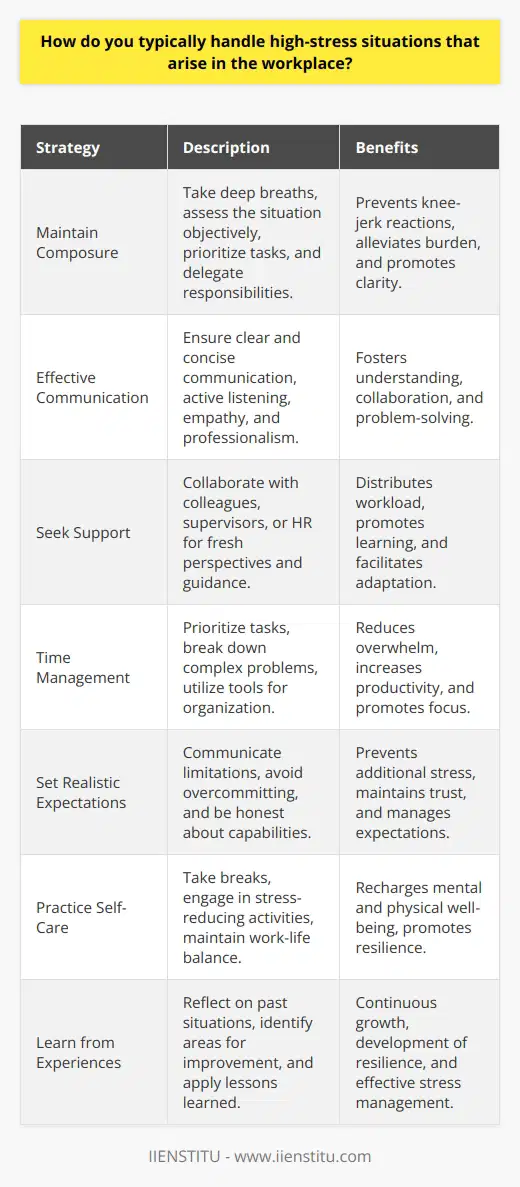
Can you provide an example of a particularly challenging high-stress situation you encountered at work and how you managed it?
One particularly challenging high-stress situation I encountered at work involved a tight deadline for a critical project. Our team had to develop and launch a new software feature within an extremely compressed timeframe. The client was demanding, and the stakes were high, as the success of the project would significantly impact our company's reputation and future business prospects.
Assessing the Situation and Developing a Plan
To manage this high-stress situation, I first took a step back to assess the challenges and resources available. I collaborated with my team to break down the project into smaller, manageable tasks and created a detailed timeline. We prioritized the most critical components and allocated resources accordingly. By creating a clear plan and setting realistic expectations, we were able to reduce anxiety and focus on execution.
Effective Communication and Collaboration
Clear and frequent communication was crucial in managing this high-stress situation. I made sure to keep all stakeholders, including the client and upper management, informed of our progress and any potential roadblocks. Regular status updates and transparent communication helped build trust and manage expectations. Within the team, we held daily stand-up meetings to discuss progress, address issues, and provide support to one another.
Adaptability and Problem-Solving
Throughout the project, we encountered several unexpected challenges that added to the stress. However, I encouraged my team to remain adaptable and focus on problem-solving. When faced with technical hurdles, we brainstormed solutions and sought guidance from experts when necessary. By maintaining a positive attitude and a solution-oriented mindset, we were able to navigate the challenges and find creative ways to overcome them.
Stress Management Techniques
To manage my own stress levels during this challenging situation, I practiced several techniques. I prioritized self-care by taking short breaks, practicing deep breathing exercises, and maintaining a healthy work-life balance. I also made sure to celebrate small victories along the way and express gratitude to my team members for their hard work and dedication. By focusing on the progress we were making and maintaining a positive outlook, I was able to keep my stress in check.
Successful Outcome and Lessons Learned
Despite the high-stress situation, our team successfully delivered the project on time and exceeded the client's expectations. The experience taught me valuable lessons about effective leadership, communication, and resilience in the face of challenges. I learned the importance of breaking down complex problems, collaborating with others, and maintaining a positive mindset. These lessons have served me well in subsequent high-stress situations, enabling me to approach them with greater confidence and effectiveness.
In conclusion, managing high-stress situations at work requires a combination of strategic planning, effective communication, adaptability, and personal stress management techniques. By developing these skills and maintaining a solution-oriented mindset, it is possible to navigate even the most challenging situations and achieve successful outcomes.
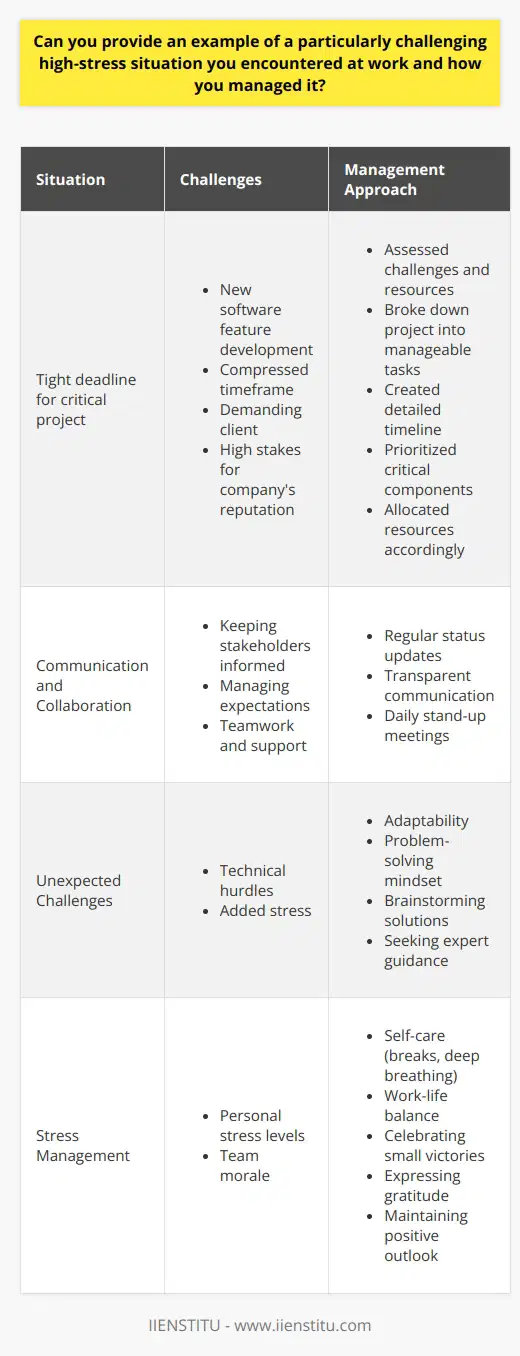
In your experience, what strategies have you found to be most effective in dealing with high-stress scenarios in a professional setting?
In my experience, several strategies have proven effective in managing high-stress scenarios in a professional setting. One of the most crucial techniques is maintaining open and clear communication channels with colleagues and supervisors. By keeping everyone informed about the situation and any progress made, you can minimize confusion and ensure that everyone is working towards the same goal. Additionally, it's essential to prioritize tasks and focus on the most critical aspects of the problem at hand. This approach helps to streamline efforts and ensures that resources are allocated efficiently.
Staying Calm and Focused
Another vital strategy is to remain calm and focused, even in the face of intense pressure. Taking deep breaths, practicing mindfulness, or engaging in brief relaxation exercises can help maintain a clear head and prevent emotions from clouding judgment. It's also important to remember that stress is a natural response to challenging situations, and acknowledging its presence can help you manage it more effectively. By staying composed, you can think more clearly and make better decisions, which is crucial in high-stress scenarios.
Breaking Down Complex Problems
When faced with a complex problem, it's helpful to break it down into smaller, more manageable components. This approach allows you to tackle the issue piece by piece, making it less overwhelming and more achievable. By focusing on one aspect at a time, you can ensure that each part of the problem receives the attention it deserves and that no critical details are overlooked. This strategy also helps to maintain a sense of progress, which can be motivating and reduce stress levels.
Leveraging Team Strengths
In high-stress situations, it's crucial to leverage the strengths of your team members. By assigning tasks based on each individual's skills and expertise, you can ensure that the most qualified person handles each aspect of the problem. This approach not only increases the likelihood of success but also helps to distribute the workload evenly, reducing the burden on any single team member. Furthermore, collaborating with colleagues can provide fresh perspectives and ideas, which can be invaluable when dealing with complex issues.
Learning from Experience
Finally, it's essential to learn from each high-stress experience and use that knowledge to improve future responses. After the situation has been resolved, take time to reflect on what worked well and what could have been done differently. By identifying areas for improvement, you can develop more effective strategies for handling similar scenarios in the future. Additionally, sharing these insights with your team can help foster a culture of continuous learning and growth, which can be beneficial in navigating future challenges.
Conclusion
In conclusion, dealing with high-stress scenarios in a professional setting requires a combination of effective communication, prioritization, focus, problem-solving, teamwork, and continuous learning. By implementing these strategies and remaining adaptable, you can navigate even the most challenging situations with greater ease and success.
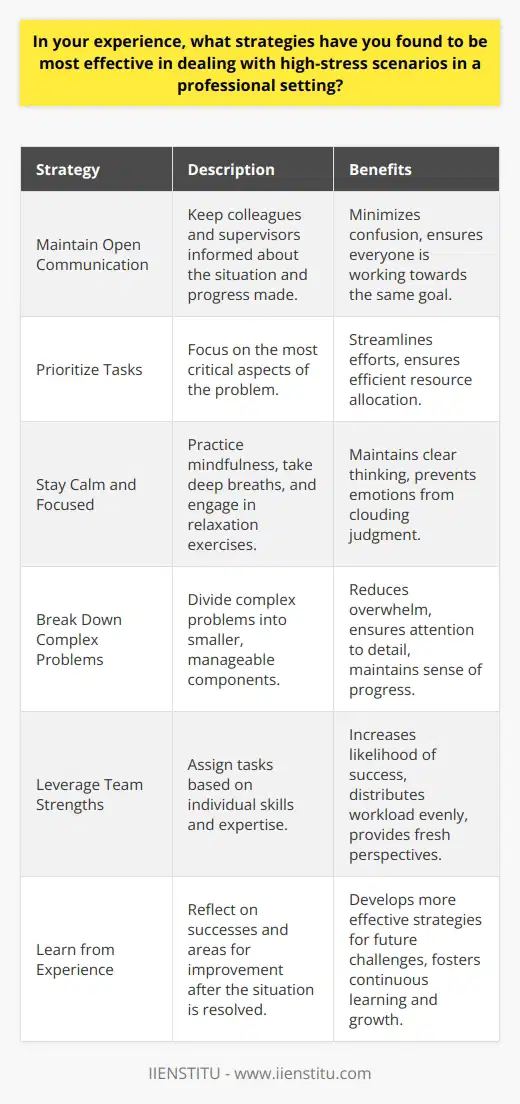
How can you effectively manage and cope with a stressful situation at work?
Managing and coping with stressful situations at work is crucial for maintaining productivity and well-being. Several strategies can be employed to effectively deal with such situations.
Identify the Source of Stress
The first step in managing stress is to identify its source. Take a moment to analyze what is causing the stress. Is it a tight deadline, a challenging project, or a conflict with a colleague?
Prioritize Tasks
Once the source of stress is identified, prioritize tasks based on their importance and urgency. Focus on the most critical tasks first. Break larger projects into smaller, manageable steps to avoid feeling overwhelmed.
Communicate Effectively
Effective communication is key to managing stress at work. If you feel overwhelmed, don't hesitate to ask for help or clarification. Engage in open and honest conversations with your colleagues and supervisors to address any concerns or conflicts.
Practice Time Management
Proper time management can significantly reduce stress levels. Use tools like calendars, to-do lists, and project management software to organize your tasks. Set realistic goals and deadlines, and allocate sufficient time for each task.
Take Breaks and Practice Self-Care
Taking regular breaks throughout the day can help manage stress. Step away from your desk, stretch, or take a short walk. Engage in activities that promote relaxation, such as deep breathing exercises or meditation.
Maintain a Healthy Work-Life Balance
Establishing a healthy work-life balance is essential for managing stress. Set boundaries between your work and personal life. Avoid checking work emails or taking work-related calls outside of working hours. Engage in hobbies and activities that bring you joy and help you unwind.
Seek Support
Don't hesitate to seek support when dealing with stressful situations at work. Reach out to trusted colleagues, friends, or family members for advice and encouragement. If the stress becomes overwhelming, consider seeking professional help from a therapist or counselor.
Learn from Stressful Experiences
Reflect on stressful situations and learn from them. Identify what worked well in managing the stress and what could be improved. Use these insights to develop a personalized stress management plan for future situations.
By implementing these strategies, you can effectively manage and cope with stressful situations at work. Remember, stress is a natural part of life, but it's how you respond to it that matters. With the right tools and mindset, you can navigate challenging situations and maintain a healthy and productive work environment.

What strategies can be employed to remain calm and focused when faced with a challenging and stressful scenario?
When faced with a challenging and stressful scenario, employing effective strategies can help individuals remain calm and focused. One crucial approach involves practicing deep breathing techniques, which can slow down the heart rate and reduce anxiety levels. Engaging in mindfulness meditation, even for a few minutes, can also promote a sense of inner peace and clarity. Additionally, reframing negative thoughts into positive ones can significantly alter one's perspective and emotional response to the situation.
Prioritize and Break Down Tasks
Another strategy to maintain focus during stressful times is to prioritize tasks and break them down into smaller, manageable steps. This approach prevents overwhelming feelings and allows individuals to tackle challenges systematically. Creating a clear action plan and setting realistic goals can provide a sense of control and direction, reducing stress levels. It is also essential to take short breaks when needed, as they offer opportunities to recharge and regain mental clarity.
Seek Support and Communicate Effectively
Seeking support from trusted friends, family members, or colleagues can be incredibly beneficial during challenging times. Sharing concerns and feelings with others can provide a fresh perspective and alleviate the burden of facing difficulties alone. Effective communication is key in these situations, as it allows individuals to express their needs and expectations clearly, reducing the likelihood of misunderstandings and additional stress.
Practice Self-Care and Maintain a Healthy Lifestyle
Engaging in regular self-care activities, such as exercise, hobbies, or relaxation techniques, is crucial for managing stress and maintaining focus. Physical activity releases endorphins, which can improve mood and reduce anxiety. Adequate sleep and a balanced diet also play vital roles in promoting mental well-being and resilience. By prioritizing self-care and maintaining a healthy lifestyle, individuals can build the necessary mental and emotional stamina to navigate challenging situations effectively.
Embrace Adaptability and Learn from Experiences
Lastly, embracing adaptability and viewing challenges as opportunities for growth can help individuals remain calm and focused. Recognizing that change is inevitable and adopting a flexible mindset can make it easier to navigate unexpected obstacles. Reflecting on past experiences and learning from them can also enhance problem-solving skills and build confidence in one's ability to overcome future challenges. By cultivating a growth-oriented perspective, individuals can approach stressful scenarios with greater resilience and determination.
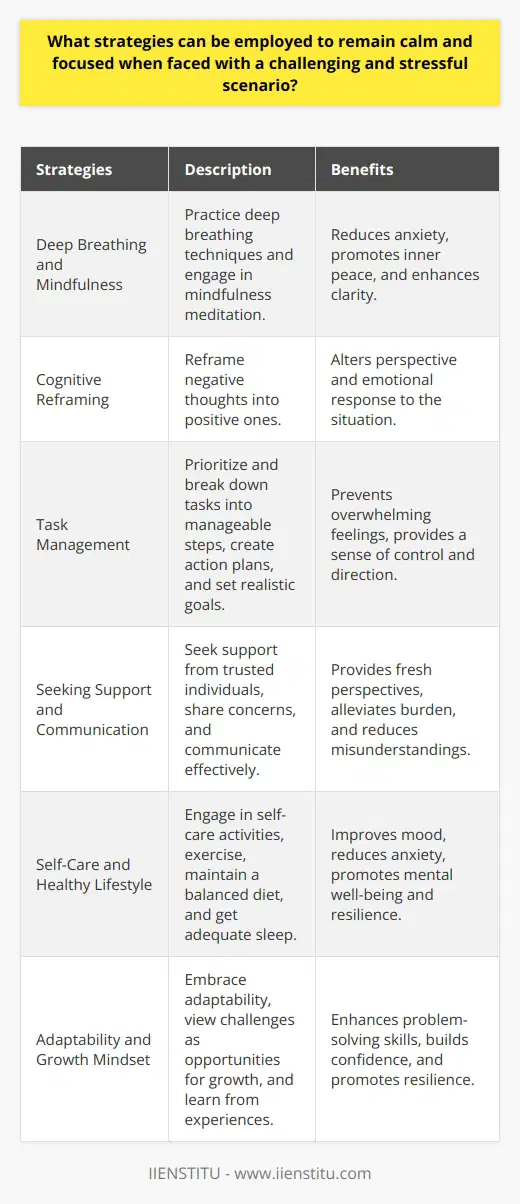
Can you provide an example of a stressful situation you encountered and explain how you successfully navigated through it?
One example of a stressful situation I encountered was during my final year of university. I had to complete a major research project while also studying for exams and working part-time. The pressure to perform well in all areas was immense, and I found myself feeling overwhelmed and anxious.
Prioritizing Tasks
To navigate through this stressful situation, I first prioritized my tasks. I made a list of all the things I needed to accomplish and ranked them in order of importance and urgency. This helped me focus on the most critical tasks and avoid getting bogged down by less important ones.
Breaking Down Large Projects
I then broke down my research project into smaller, more manageable chunks. Instead of trying to tackle the entire project at once, I set daily and weekly goals for myself. This made the project feel less daunting and helped me make steady progress.
Creating a Schedule
Next, I created a detailed schedule for myself. I allocated specific times for studying, working on my research project, and my part-time job. I also made sure to schedule in breaks and time for self-care, such as exercise and relaxation.
Communicating with Others
I also reached out to my professors and employer to communicate my situation. I asked for extensions on deadlines when needed and made sure to keep them updated on my progress. This helped alleviate some of the pressure and ensured that I had the support I needed.
Practicing Stress-Management Techniques
Finally, I practiced stress-management techniques to help me cope with the pressure. I made sure to get enough sleep, eat well, and exercise regularly. I also used relaxation techniques such as deep breathing and meditation to calm my mind and reduce anxiety.
Focusing on the Present
Throughout the process, I tried to focus on the present moment rather than worrying about the future. I reminded myself that I could only control my actions in the present and that worrying about potential outcomes would only increase my stress levels.
Celebrating Small Victories
I also made sure to celebrate my small victories along the way. Each time I completed a task or made progress on my project, I took a moment to acknowledge my hard work and feel proud of myself. This helped keep me motivated and focused on my goals.
Learning from the Experience
Looking back, this stressful situation taught me valuable lessons about time management, prioritization, and stress management. It also showed me the importance of seeking help and support when needed and celebrating my accomplishments along the way.
By breaking down the situation into smaller, more manageable parts, communicating with others, and practicing self-care, I was able to successfully navigate through this stressful period and come out stronger on the other side.
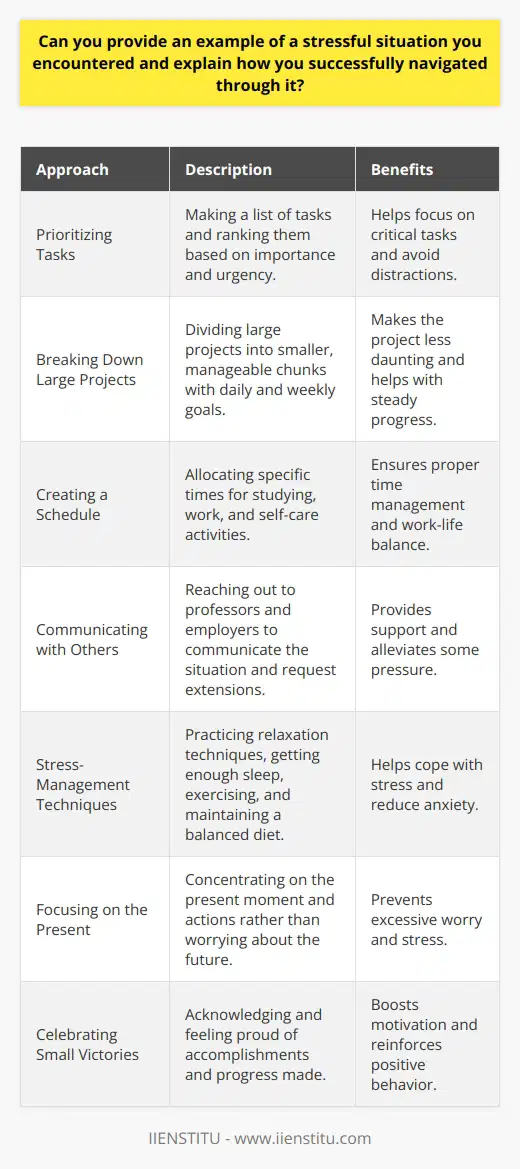
How do you typically cope with stress in a high-pressure work environment?
Coping with stress in a high-pressure work environment is crucial for maintaining productivity and well-being. There are several strategies that individuals can employ to manage stress effectively. One approach is to prioritize tasks and manage time efficiently, which helps reduce the feeling of being overwhelmed. Breaking down large projects into smaller, manageable tasks can make them feel less daunting and more achievable.
Effective Communication and Support
Open communication with colleagues and supervisors is another key factor in managing stress. Discussing concerns, seeking clarification, and asking for help when needed can alleviate the burden of trying to handle everything alone. Building a support network of trusted coworkers can provide a sense of camaraderie and a safe space to share challenges and solutions.
Maintaining Work-Life Balance
Establishing clear boundaries between work and personal life is essential for reducing stress. Setting aside dedicated time for hobbies, exercise, and relaxation allows the mind and body to recharge. Engaging in activities that bring joy and fulfillment outside of work helps maintain a healthy perspective and prevents burnout.
Practicing Mindfulness and Relaxation Techniques
Incorporating mindfulness and relaxation techniques into daily routines can be highly beneficial for stress management. Deep breathing exercises, meditation, or even brief stretching breaks can help calm the mind and reduce physical tension. These practices can be done discreetly at a desk or during short breaks throughout the workday.
Seeking Professional Help
In cases where stress becomes overwhelming or persistent, seeking professional help is a wise choice. Many workplaces offer employee assistance programs that provide confidential counseling services. Talking to a therapist or counselor can help individuals develop personalized coping strategies and gain a fresh perspective on work-related challenges.
Promoting a Positive Work Environment
Employers also play a significant role in helping employees manage stress. Fostering a positive work environment that encourages open communication, recognizes achievements, and provides opportunities for growth can greatly reduce stress levels. Implementing policies that promote work-life balance, such as flexible working hours or remote work options, can further support employees' well-being.
Ultimately, coping with stress in a high-pressure work environment requires a combination of individual strategies and organizational support. By prioritizing self-care, maintaining healthy boundaries, and seeking help when needed, individuals can navigate the challenges of a demanding workplace while preserving their mental and physical health.
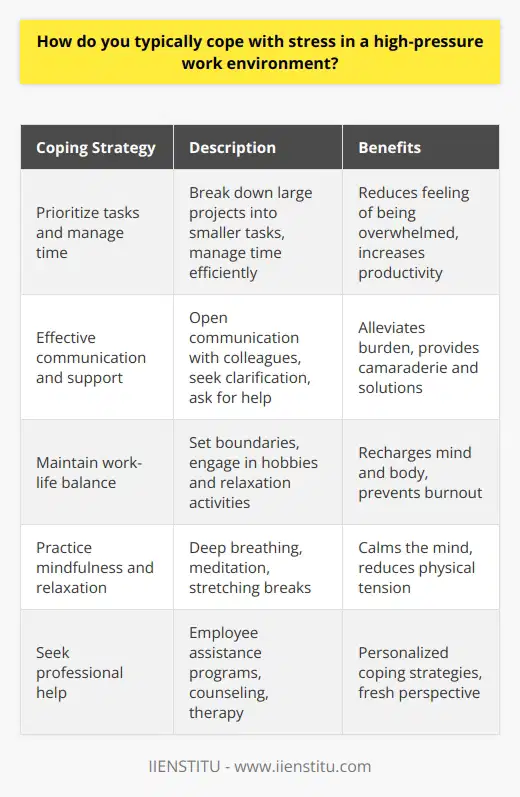
What strategies have you found to be most effective in managing stress and maintaining composure during difficult circumstances at work?
Effective stress management strategies in the workplace are crucial for maintaining composure and productivity during challenging situations. One of the most valuable techniques is practicing mindfulness and deep breathing exercises. Taking a few minutes to focus on the present moment and regulate breathing can significantly reduce stress levels and improve clarity of thought. Additionally, prioritizing tasks and breaking them down into manageable steps can help prevent feeling overwhelmed by work demands.
Importance of Self-Care
Engaging in regular self-care activities outside of work is another essential strategy for managing stress. This includes maintaining a balanced diet, getting sufficient sleep, and exercising regularly. These practices contribute to overall well-being and increase resilience to stress. Furthermore, setting clear boundaries between work and personal life is crucial. Disconnecting from work-related tasks and communications during off-hours allows for mental rest and rejuvenation.
Effective Communication and Support Systems
Open communication with colleagues and supervisors is also vital in managing workplace stress. Discussing concerns and seeking support when needed can help alleviate the burden of difficult circumstances. Moreover, fostering positive relationships with coworkers creates a supportive network that can provide encouragement and assistance during challenging times.
Cognitive Reframing Techniques
Employing cognitive reframing techniques is another effective strategy for maintaining composure in stressful situations. This involves challenging negative thoughts and reframing them in a more positive or realistic light. By altering one's perspective, it becomes easier to approach difficulties with a solution-oriented mindset. Additionally, practicing self-compassion and acknowledging that setbacks and challenges are a normal part of the work experience can help reduce self-imposed pressure.
Time Management and Organization
Effective time management and organization skills are also crucial for mitigating workplace stress. Prioritizing tasks, setting realistic deadlines, and using tools like calendars and to-do lists can help streamline workflows and reduce feelings of being overwhelmed. It is also important to take regular breaks throughout the workday to recharge and maintain focus.
Seeking Professional Help
In cases where stress becomes chronic or unmanageable, seeking professional help from a therapist or counselor can be beneficial. They can provide personalized coping strategies and support to navigate difficult work situations. Many organizations also offer employee assistance programs that provide confidential counseling services for work-related stress.
By implementing a combination of these strategies, individuals can effectively manage stress and maintain composure in the face of workplace challenges. It is important to remember that stress management is an ongoing process that requires consistent effort and self-awareness. By prioritizing well-being and developing resilience, professionals can navigate difficult circumstances with greater ease and maintain optimal performance in their roles.
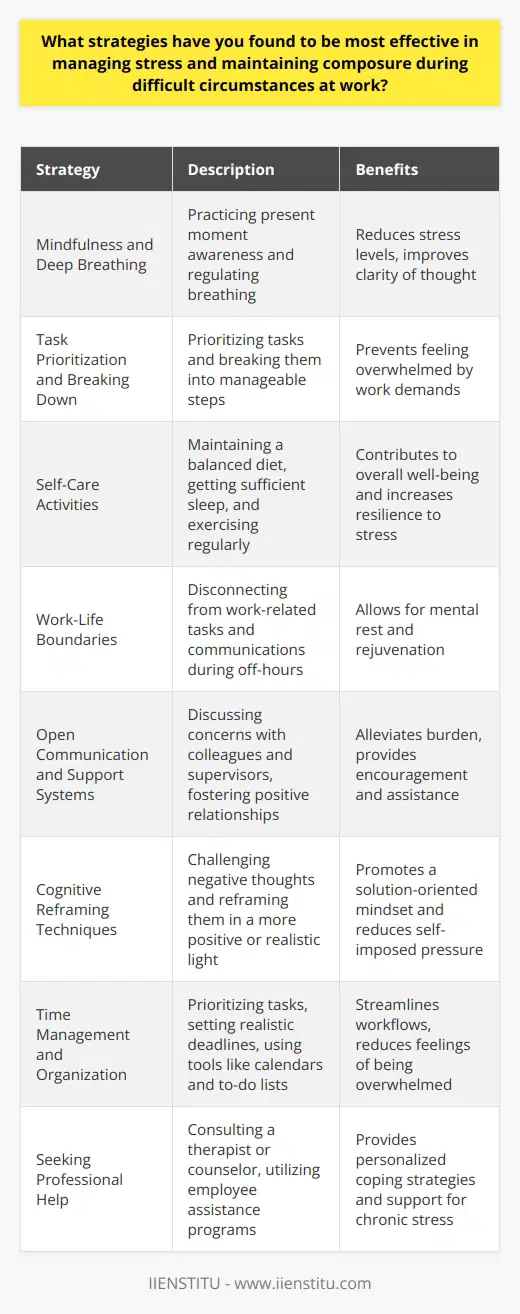
How do you typically respond to and manage stressful situations?
When faced with stressful situations, I employ a multifaceted approach to effectively respond to and manage the challenges at hand. This approach involves a combination of cognitive strategies, emotional regulation techniques, and practical problem-solving skills.
Cognitive Strategies
One of the primary ways I tackle stressful situations is by adopting a positive and rational mindset. I actively challenge negative thoughts and reframe them in a more constructive manner. By maintaining an optimistic outlook, I can better navigate the difficulties and find solutions.
Additionally, I practice mindfulness and present-moment awareness to avoid becoming overwhelmed by future uncertainties or past regrets. By focusing on the present, I can allocate my mental resources more efficiently and make clearer decisions.
Emotional Regulation Techniques
To manage the emotional impact of stressful situations, I employ various relaxation techniques. Deep breathing exercises, progressive muscle relaxation, and meditation help me calm my mind and body. These practices allow me to approach the situation with a more balanced and composed demeanor.
Moreover, I prioritize self-care activities that promote emotional well-being, such as engaging in hobbies, spending time with loved ones, and maintaining a healthy lifestyle. By nurturing my emotional resilience, I am better equipped to handle stress.
Practical Problem-Solving Skills
When confronted with a stressful situation, I break down the problem into smaller, manageable components. This approach enables me to tackle the issue systematically and avoid feeling overwhelmed. I prioritize tasks based on their urgency and importance, ensuring that I address the most critical aspects first.
Seeking Support
I acknowledge the value of seeking support from others when facing stressful circumstances. Engaging in open communication with trusted individuals, such as family, friends, or professionals, allows me to gain fresh perspectives and emotional support. Collaborating with others can lead to more effective problem-solving and reduced stress levels.
Continuous Learning and Adaptation
I view stressful situations as opportunities for personal growth and development. By reflecting on my experiences and learning from them, I continuously enhance my coping mechanisms and resilience. I remain open to adapting my strategies based on the unique demands of each situation.
Conclusion
In summary, my approach to responding to and managing stressful situations involves a combination of cognitive strategies, emotional regulation techniques, practical problem-solving skills, seeking support, and continuous learning and adaptation. By employing these strategies, I am able to navigate challenges more effectively, maintain my well-being, and foster personal growth in the face of adversity.
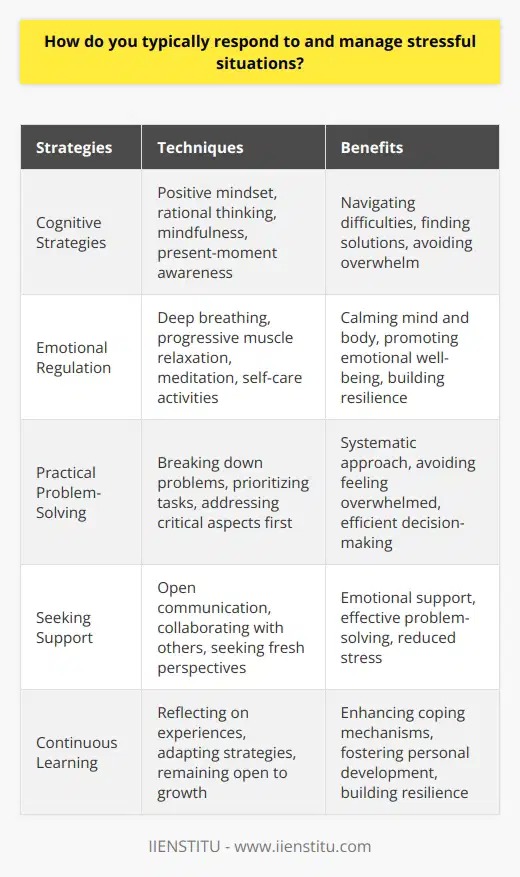
What strategies have you found effective in dealing with stress?
Dealing with stress effectively is crucial for maintaining mental and physical well-being. Several strategies can help manage stress levels and promote a healthier lifestyle. One effective approach is regular exercise, which releases endorphins and reduces tension in the body. Engaging in physical activities like jogging, yoga, or swimming can significantly alleviate stress symptoms.
Mindfulness and Relaxation Techniques
Practicing mindfulness and relaxation techniques is another powerful way to combat stress. Mindfulness involves focusing on the present moment and acknowledging thoughts and emotions without judgment. Techniques such as deep breathing exercises, meditation, and progressive muscle relaxation can help calm the mind and reduce anxiety levels. These practices promote a sense of inner peace and enhance emotional regulation.
Time Management and Prioritization
Effective time management and prioritization are essential for reducing stress caused by overwhelming tasks and responsibilities. Creating a structured schedule and breaking down large projects into smaller, manageable steps can make the workload feel less daunting. Prioritizing tasks based on importance and urgency helps focus on critical activities and prevents last-minute scrambling, which often leads to increased stress levels.
Social Support and Communication
Seeking social support and maintaining open communication with loved ones can provide a strong buffer against stress. Talking to friends, family members, or a trusted therapist about stressors and challenges can offer a fresh perspective and emotional support. Engaging in enjoyable social activities and hobbies can also serve as a distraction from stress and promote a sense of balance in life.
Self-Care and Healthy Lifestyle Habits
Practicing self-care and adopting healthy lifestyle habits are fundamental in managing stress. Ensuring adequate sleep, maintaining a balanced diet, and staying hydrated contribute to overall well-being and resilience. Engaging in hobbies and activities that bring joy and relaxation, such as reading, listening to music, or spending time in nature, can help reduce stress and promote a positive outlook on life.
Cognitive Restructuring and Positive Self-Talk
Cognitive restructuring involves identifying and challenging negative thought patterns that contribute to stress. Recognizing irrational or exaggerated thoughts and replacing them with more realistic and positive self-talk can help alleviate stress and improve mental well-being. Practicing gratitude and focusing on personal strengths and accomplishments can also foster a more optimistic mindset and enhance resilience in the face of stress.
Ultimately, finding effective stress management strategies is a personal journey that requires exploration and self-discovery. Experimenting with different techniques and identifying what works best for an individual's unique needs and preferences is key to developing a sustainable stress management plan. By incorporating a combination of exercise, mindfulness, time management, social support, self-care, and cognitive restructuring, individuals can cultivate a more resilient and balanced approach to dealing with stress in their daily lives.
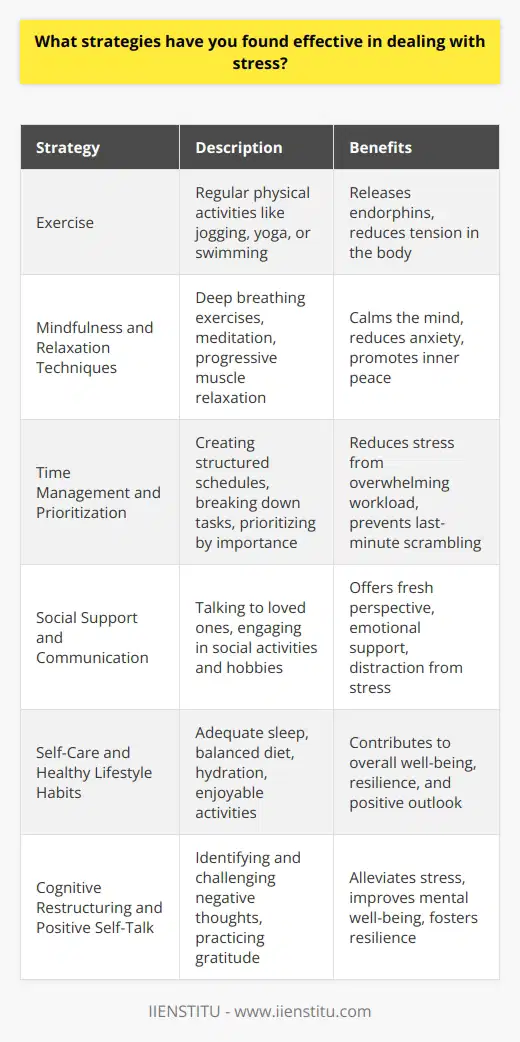
Can you describe a particularly stressful situation you faced and how you handled it?
One particularly stressful situation I faced was during my final year of university when I had to complete my dissertation. The pressure was immense as the dissertation accounted for a significant portion of my overall grade. I had to juggle multiple responsibilities, including attending classes, working part-time, and conducting research for my dissertation.
Time Management
To handle this stressful situation, I first focused on effective time management. I created a detailed schedule that allocated specific time slots for each task. I prioritized my dissertation and ensured that I dedicated enough time to research, writing, and editing. I also made sure to set realistic goals for each day and week to avoid overwhelming myself.
Breaking Down the Task
I broke down the dissertation into smaller, manageable sections. I tackled each section individually, focusing on completing one part before moving on to the next. This approach helped me avoid feeling overwhelmed by the enormity of the entire project. I set milestones for each section and celebrated small victories along the way, which kept me motivated.
Seeking Support
I sought support from my academic supervisor and peers. I regularly met with my supervisor to discuss my progress, seek guidance, and clarify any doubts. I also joined a study group with fellow students working on their dissertations. We shared ideas, provided feedback, and encouraged each other throughout the process. Having a support system helped alleviate some of the stress and provided a sense of camaraderie.
Self-Care
I recognized the importance of self-care during this stressful period. I made sure to take breaks, engage in relaxation techniques, and maintain a healthy lifestyle. I set aside time for activities I enjoyed, such as exercise, reading, and spending time with friends and family. Taking care of my physical and mental well-being helped me cope with the stress and maintain a balanced perspective.
Staying Organized
Staying organized was crucial in managing the stress associated with the dissertation. I used various tools, such as a planner, digital calendar, and note-taking apps, to keep track of deadlines, appointments, and important information. I maintained a clean and organized workspace, which helped me focus and avoid distractions.
Embracing Challenges
I tried to view the dissertation as a challenge rather than a threat. I reminded myself that I had the skills and knowledge to complete the project successfully. I embraced the opportunity to delve deeply into a topic I was passionate about and contribute to my field of study. Adopting a positive mindset helped me approach the situation with determination and resilience.
In conclusion, facing the stress of completing my dissertation taught me valuable lessons about time management, breaking down tasks, seeking support, and prioritizing self-care. By employing these strategies and maintaining a positive outlook, I was able to handle the stressful situation effectively and successfully complete my dissertation.
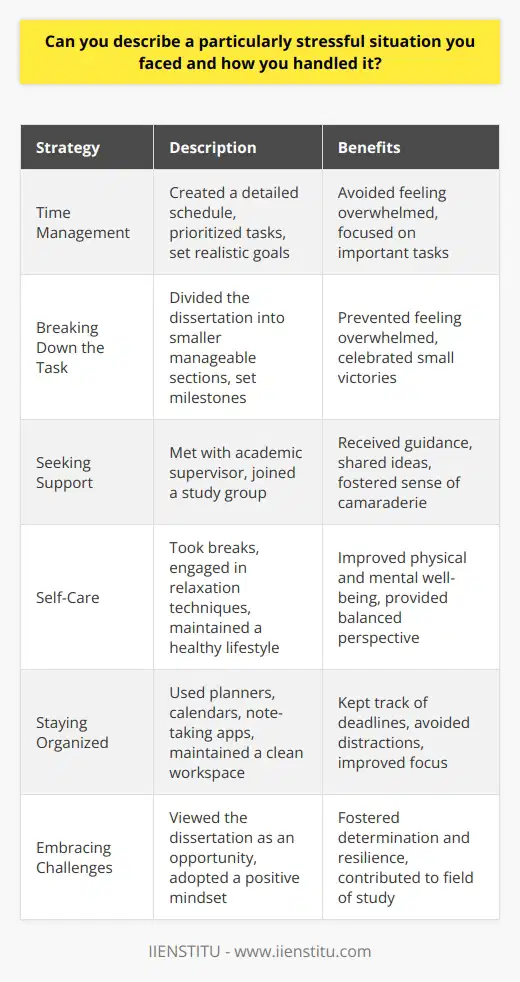
How do you handle stress and pressure in the workplace?
Stress and pressure are common challenges in the workplace that can significantly impact an individual's well-being and productivity. Effectively managing these factors is crucial for maintaining a healthy work-life balance and achieving professional success. Several strategies can be employed to handle stress and pressure in the workplace constructively.
Identifying Stressors and Triggers
The first step in managing stress and pressure is to identify the specific factors contributing to these feelings. This may include heavy workloads, tight deadlines, conflicts with colleagues, or a lack of work-life balance. By recognizing the sources of stress, individuals can develop targeted strategies to address them effectively.
Time Management and Prioritization
Effective time management and prioritization are essential for reducing stress and pressure in the workplace. This involves setting clear goals, breaking tasks into manageable steps, and allocating time efficiently. Prioritizing tasks based on importance and urgency can help individuals focus on critical responsibilities and avoid feeling overwhelmed.
Techniques for Time Management
Use a planner or digital tools to organize tasks and deadlines
Break large projects into smaller, achievable milestones
Delegate tasks when appropriate to distribute workload
Effective Communication and Support
Open and honest communication with colleagues and supervisors can alleviate stress and pressure in the workplace. Discussing concerns, seeking clarification on expectations, and asking for support when needed can help individuals feel more supported and less burdened. Building positive relationships with coworkers can also provide a network of support during challenging times.
Strategies for Effective Communication
Regularly communicate progress, challenges, and needs with supervisors
Participate in team meetings and discussions to foster collaboration
Seek feedback and guidance from colleagues and mentors
Self-Care and Stress-Reduction Techniques
Incorporating self-care practices and stress-reduction techniques into daily routines can help manage stress and pressure in the workplace. This may include engaging in regular exercise, practicing mindfulness or meditation, maintaining a healthy diet, and getting sufficient sleep. Taking short breaks throughout the workday to recharge and refocus can also be beneficial.
Examples of Self-Care Practices
Engage in physical activities like yoga, walking, or cycling
Practice deep breathing exercises or meditation during breaks
Maintain a balanced diet and stay hydrated throughout the day
Establishing Boundaries and Work-Life Balance
Setting clear boundaries between work and personal life is crucial for managing stress and pressure. This involves establishing realistic expectations, learning to say no when necessary, and disconnecting from work-related tasks during non-work hours. Prioritizing personal time, hobbies, and relationships can help individuals maintain a sense of balance and reduce overall stress levels.
Tips for Maintaining Work-Life Balance
Set specific work hours and stick to them as much as possible
Communicate boundaries with colleagues and supervisors
Engage in hobbies and activities outside of work to reduce stress
By implementing these strategies and techniques, individuals can effectively handle stress and pressure in the workplace. Developing a proactive approach to stress management, fostering a supportive work environment, and prioritizing self-care can lead to increased resilience, improved well-being, and enhanced professional performance.
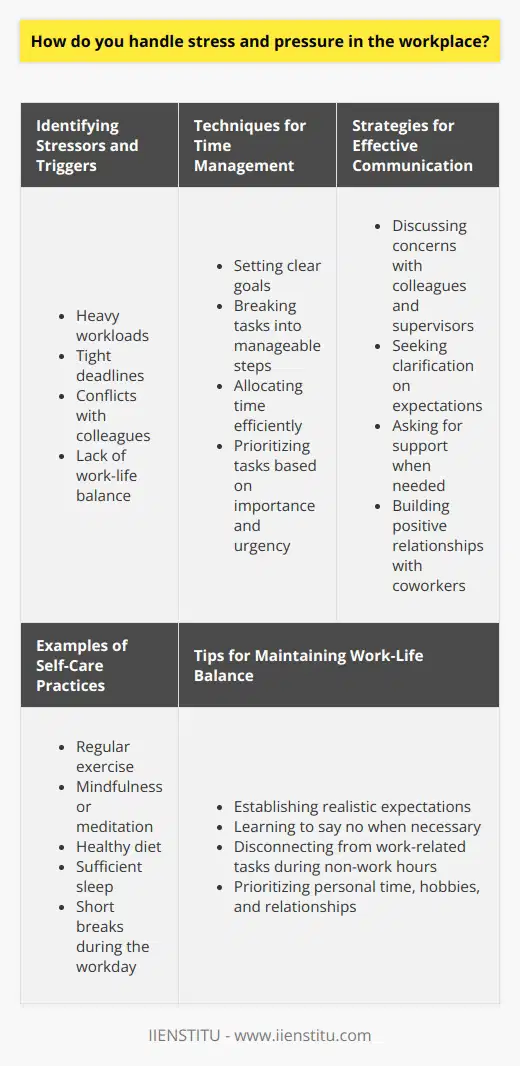
What strategies do you employ to manage stress and pressure effectively?
Managing stress and pressure effectively is crucial for maintaining well-being and achieving success in various aspects of life. One key strategy is to identify the sources of stress and prioritize tasks accordingly. By recognizing the most pressing concerns and focusing on them first, individuals can reduce feelings of overwhelm and increase their sense of control over the situation.
Time Management Techniques
Implementing effective time management techniques is another essential approach to managing stress and pressure. This involves creating a schedule, setting realistic goals, and breaking larger tasks into smaller, more manageable steps. By allocating specific time slots for different activities and responsibilities, individuals can ensure that they are making progress towards their objectives while also leaving room for self-care and relaxation.
Prioritizing Self-Care
Engaging in regular self-care practices is vital for managing stress and pressure. This includes activities such as exercise, meditation, deep breathing exercises, and pursuing hobbies or interests. By dedicating time to activities that promote physical, mental, and emotional well-being, individuals can build resilience and improve their ability to cope with challenging situations.
Seeking Support
Building a strong support network is another crucial strategy for managing stress and pressure. This involves reaching out to friends, family members, or professionals for guidance, advice, or simply a listening ear. By sharing concerns and feelings with others, individuals can gain new perspectives, receive encouragement, and feel less isolated in their struggles.
Maintaining Work-Life Balance
Establishing and maintaining a healthy work-life balance is essential for managing stress and pressure. This involves setting clear boundaries between work and personal life, learning to say no to non-essential commitments, and carving out time for relaxation and enjoyable activities. By prioritizing a balanced lifestyle, individuals can reduce the risk of burnout and maintain a sense of well-being even in the face of challenging circumstances.
Developing a Growth Mindset
Cultivating a growth mindset is another powerful strategy for managing stress and pressure. This involves viewing challenges as opportunities for learning and growth, rather than as threats or obstacles. By embracing a positive attitude and focusing on the lessons that can be gained from difficult experiences, individuals can build resilience and develop a greater sense of self-efficacy.
Practicing Mindfulness
Incorporating mindfulness practices into daily life can also be an effective way to manage stress and pressure. This involves paying attention to the present moment, without judgment, and accepting thoughts and feelings as they arise. By cultivating a sense of awareness and presence, individuals can reduce the impact of stress and improve their overall well-being.
In conclusion, managing stress and pressure effectively requires a multifaceted approach that encompasses various strategies and techniques. By prioritizing tasks, implementing effective time management, engaging in self-care, seeking support, maintaining work-life balance, developing a growth mindset, and practicing mindfulness, individuals can build resilience and navigate challenging situations with greater ease and confidence.
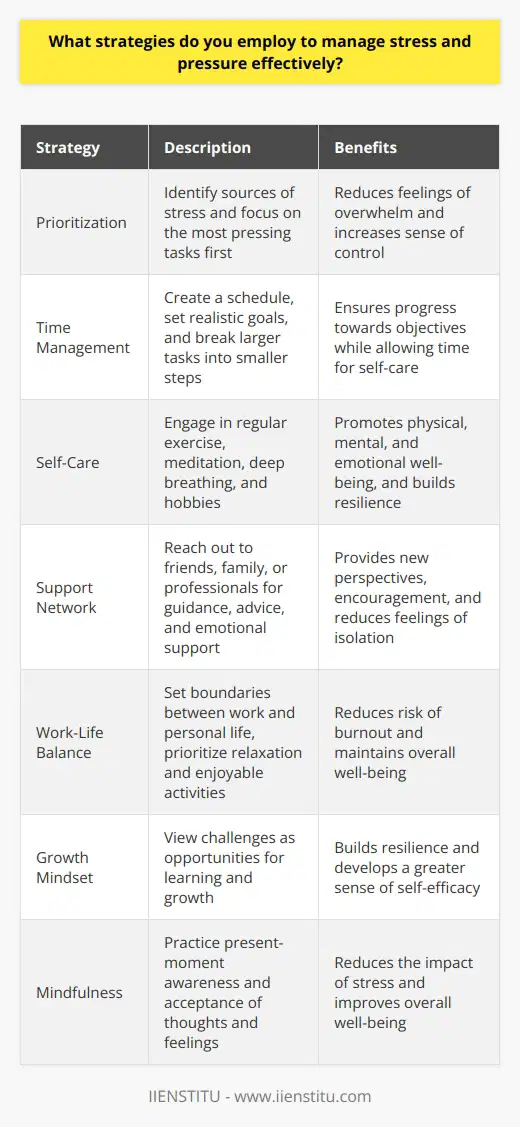
How do you maintain composure and productivity when faced with stressful situations?
Maintaining composure and productivity in stressful situations is a crucial skill for success in both personal and professional life. Effective stress management techniques can help individuals remain calm, focused, and efficient even under pressure. One key strategy is to practice mindfulness, which involves being present in the moment and observing thoughts and emotions without judgment. This can help prevent stress from overwhelming the mind and interfering with decision-making abilities.
Prioritize and Plan
Another important aspect of maintaining composure and productivity is prioritizing tasks and creating a clear plan of action. By breaking down larger goals into smaller, manageable steps, individuals can avoid feeling overwhelmed and maintain a sense of control. It is also essential to set realistic expectations and deadlines, allowing for flexibility and adjustments as needed.
Self-Care and Stress Relief
Engaging in regular self-care activities, such as exercise, meditation, or hobbies, can help reduce stress levels and improve overall well-being. These activities provide an opportunity to step away from stressful situations and recharge, ultimately enhancing resilience and the ability to cope with challenges.
Communication and Support
Effective communication is another crucial component of maintaining composure and productivity during stressful times. Openly discussing concerns and seeking support from colleagues, supervisors, or loved ones can help alleviate feelings of isolation and provide valuable perspectives and solutions. Building a strong support network can offer encouragement and guidance when facing difficult situations.
Adaptability and Positive Mindset
Cultivating a positive mindset and embracing adaptability are essential for navigating stressful circumstances. Reframing challenges as opportunities for growth and learning can help maintain motivation and prevent feelings of helplessness or frustration. By remaining flexible and open to change, individuals can more easily adjust their approach and find creative solutions to problems.
Continuous Learning and Improvement
Finally, continuously learning and developing stress management skills is crucial for long-term success. Attending workshops, reading relevant books, or seeking guidance from mentors can provide valuable insights and techniques for effectively handling stressful situations. By actively working to improve stress management abilities, individuals can build greater resilience and maintain composure and productivity even in the face of adversity.
Conclusion
In conclusion, maintaining composure and productivity in stressful situations requires a combination of mindfulness, planning, self-care, communication, adaptability, and continuous learning. By implementing these strategies and developing a strong support system, individuals can effectively navigate challenges and achieve success in both their personal and professional lives.
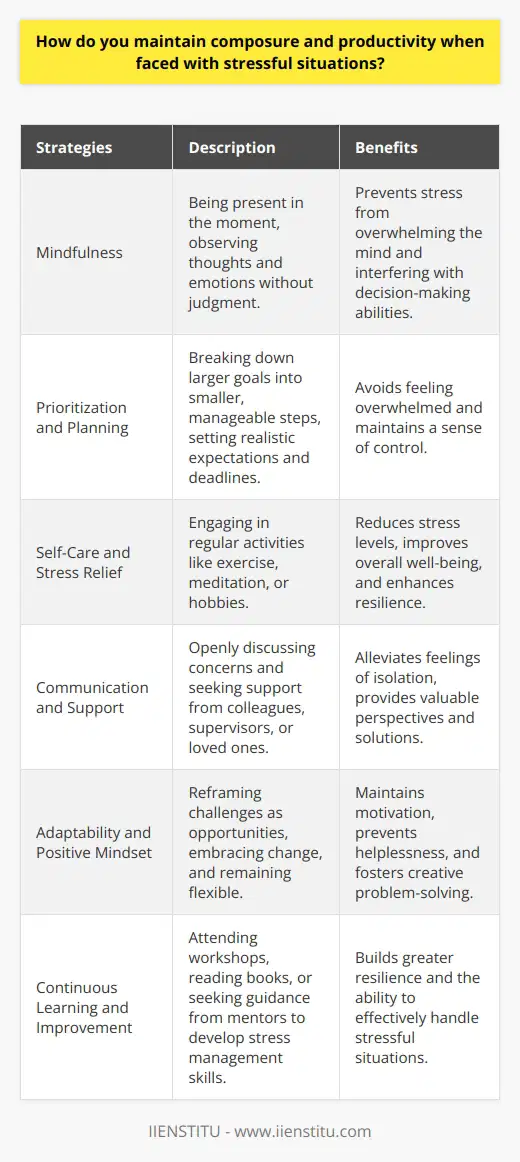
What are some common questions asked during a stress interview, and how should candidates respond to them?
Stress interviews are designed to assess a candidate's ability to handle pressure and think on their feet. Interviewers may ask challenging or unexpected questions to see how the candidate reacts and responds. Some common questions asked during a stress interview include:
Personal Weaknesses
Interviewers may ask candidates to discuss their biggest weaknesses or failures. Candidates should answer honestly but strategically. They should choose a weakness that won't directly impact their ability to perform the job. They should also explain how they are working to improve this weakness.
Hypothetical Scenarios
Interviewers may present hypothetical scenarios and ask candidates how they would handle them. These scenarios are often challenging or stressful situations. Candidates should remain calm and think through their response logically. They should explain their thought process and propose a solution or course of action.
Example Scenario
An interviewer might ask, "How would you handle a situation where a client is angry and dissatisfied with your work?" The candidate should outline steps to address the client's concerns, take responsibility, and find a resolution.
Unconventional Questions
Interviewers may ask seemingly random or unrelated questions to see how candidates think on their feet. These could be brainteasers or riddles. Candidates should take a moment to gather their thoughts before responding. They should walk through their reasoning out loud so the interviewer can understand their problem-solving process.
Example Question
An interviewer might ask, "How many tennis balls can fit inside a limousine?" The candidate should ask clarifying questions, make reasonable assumptions, and talk through their calculations.
Responding to Stress Interview Questions
When responding to stress interview questions, candidates should:
Remain calm and composed, even if the question catches them off guard.
Take a moment to collect their thoughts before responding.
Answer honestly and strategically, focusing on their strengths and problem-solving abilities.
Provide specific examples to illustrate their points whenever possible.
Maintain a positive attitude and demonstrate enthusiasm for the opportunity.
Preparing for a Stress Interview
To prepare for a stress interview, candidates should:
Research common stress interview questions and practice their responses.
Work on remaining calm under pressure through techniques like deep breathing or meditation.
Reflect on past challenges and how they successfully navigated them.
Focus on their strengths and unique value proposition as a candidate.
By understanding common stress interview questions and preparing thoughtful responses, candidates can demonstrate their ability to handle pressure and think critically - valuable skills in any role.
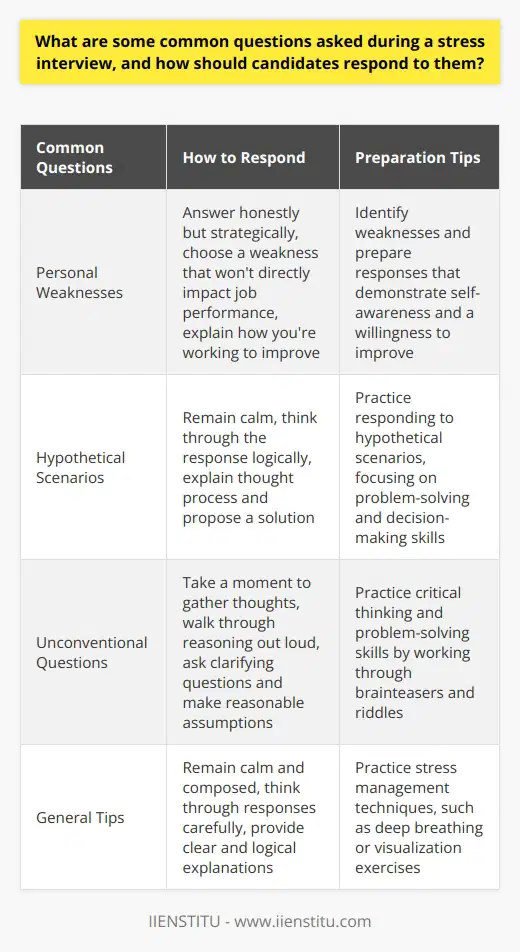
How can job seekers prepare for the high-pressure scenarios often presented in stress interviews?
Job seekers can prepare for high-pressure scenarios in stress interviews by practicing common questions and developing coping strategies. Researching the company and the role can help candidates anticipate potential challenges and formulate thoughtful responses. Engaging in mock interviews with friends, family, or career coaches can simulate the pressure of real interviews. During these practice sessions, job seekers should focus on maintaining composure, articulating their thoughts clearly, and demonstrating problem-solving skills.
Building Resilience
Developing mental resilience is crucial for navigating stress interviews. Candidates should practice mindfulness techniques, such as deep breathing and positive self-talk. Engaging in regular exercise and maintaining a healthy lifestyle can also improve stress management. By cultivating a growth mindset and embracing challenges as opportunities for learning, job seekers can approach stress interviews with greater confidence and adaptability.
Showcasing Problem-Solving Skills
Stress interviews often present hypothetical scenarios or brainteasers to assess a candidate's problem-solving abilities. To prepare, job seekers should familiarize themselves with common types of problems and practice breaking them down into manageable steps. Demonstrating a structured approach, asking clarifying questions, and articulating the thought process behind solutions can impress interviewers. Candidates should also be prepared to think on their feet and adapt to unexpected challenges.
Maintaining Professionalism
Despite the high-pressure environment, it is essential to maintain professionalism throughout the interview. Job seekers should practice active listening, avoid interrupting the interviewer, and respond calmly and concisely. Dressing appropriately, arriving on time, and displaying positive body language can also contribute to a professional demeanor. By remaining poised and focused, candidates can demonstrate their ability to handle stress and perform effectively in challenging situations.
Leveraging Emotional Intelligence
Emotional intelligence plays a significant role in navigating stress interviews. Job seekers should practice self-awareness, recognizing their own emotions and triggers in high-pressure situations. By developing strategies to regulate their emotions, such as taking deep breaths or reframing negative thoughts, candidates can maintain composure and respond effectively. Additionally, demonstrating empathy and active listening skills can help build rapport with the interviewer and showcase interpersonal abilities.
Reflecting and Learning
After each stress interview, job seekers should take time to reflect on their performance. Identifying areas for improvement and seeking feedback from trusted mentors can help refine interview skills. By viewing stress interviews as learning opportunities and continuously working on personal and professional development, candidates can become more resilient and adaptable in the face of high-pressure scenarios.

What are the key strategies for maintaining composure and demonstrating resilience when faced with challenging stress interview questions?
Maintaining composure and demonstrating resilience during challenging stress interview questions require a combination of mental preparation and practical strategies. First, it's essential to understand that the interviewer's goal is to assess your ability to handle pressure and think critically. Anticipating potential stress questions and practicing your responses can help you feel more confident and composed during the interview. Additionally, taking deep breaths and maintaining a calm demeanor through body language can help you project resilience.
Mental Preparation
Mental preparation is crucial for maintaining composure during stress interviews. Before the interview, research the company and the position thoroughly. Anticipate potential stress questions and practice your responses. Visualize yourself handling the questions calmly and confidently. Remind yourself of your qualifications and achievements to boost your self-assurance.
Practical Strategies
During the interview, employ practical strategies to demonstrate resilience. Take a moment to collect your thoughts before responding to challenging questions. Speak slowly and clearly, and maintain eye contact with the interviewer. Use specific examples from your experience to illustrate your ability to handle stress and solve problems. If you don't know an answer, admit it honestly and express your willingness to learn.
Body Language
Your body language can convey confidence and resilience during stress interviews. Sit up straight and maintain good posture. Use open, expansive gestures to project confidence. Avoid fidgeting or crossing your arms, as these can signal discomfort or defensiveness. Smile genuinely and maintain a friendly, engaged facial expression.
Emotional Regulation
Regulating your emotions is essential for maintaining composure under stress. Take deep, calming breaths to relax your body and mind. If you feel overwhelmed, pause for a moment to collect yourself. Reframe negative thoughts into positive, constructive ones. Focus on the present moment and the opportunity to showcase your skills and experience.
Post-Interview Reflection
After the interview, take time to reflect on your performance. Celebrate your successes and identify areas for improvement. Use the experience to refine your stress management techniques for future interviews. Remember that every challenge is an opportunity for growth and learning.
Continuous Skill Development
Maintaining composure and resilience during stress interviews is a skill that can be developed over time. Seek opportunities to practice your communication and problem-solving skills. Engage in stress-reducing activities like exercise, meditation, or hobbies. Build a support network of mentors and colleagues who can offer guidance and encouragement.
By combining mental preparation, practical strategies, body language, emotional regulation, reflection, and continuous skill development, you can effectively maintain composure and demonstrate resilience when faced with challenging stress interview questions. Remember that the interviewer is not trying to trick you, but rather assess your ability to handle pressure and think on your feet. Approach the interview with confidence, authenticity, and a growth mindset, and you'll be well-equipped to navigate even the most challenging questions.

How do you typically handle high-stress situations in the workplace?
When faced with high-stress situations in the workplace, I typically employ a multi-faceted approach to effectively manage and overcome the challenges at hand. Drawing from my personal experiences, I have found that the key to successfully navigating these demanding circumstances lies in maintaining a clear and focused mindset, coupled with a proactive and adaptable problem-solving strategy.
Keeping a Cool Head
One of the most critical aspects of handling high-stress situations is the ability to remain calm and composed. In my experience, allowing emotions to take over can cloud judgment and hinder decision-making capabilities. By taking a moment to pause, breathe deeply, and assess the situation objectively, I am better equipped to tackle the problem head-on.
I recall a particularly stressful project I worked on last year, where tight deadlines and unexpected setbacks threatened to derail our progress. By maintaining a level-headed approach and focusing on finding solutions rather than dwelling on the problems, I was able to rally my team and deliver the project on time.
Breaking Down the Problem
When confronted with a high-stress situation, I find it helpful to break down the problem into smaller, more manageable components. By doing so, I can prioritize tasks, delegate responsibilities, and develop a clear action plan to address each aspect of the challenge systematically.
This approach has proven invaluable in my role as a project manager, where I am often required to juggle multiple competing priorities and stakeholder expectations. By breaking down complex problems into bite-sized pieces, I can ensure that my team remains focused and productive, even under intense pressure.
Leveraging Collaboration and Communication
Another crucial element in effectively handling high-stress situations is the power of collaboration and communication. I strongly believe that no one should have to face a challenge alone, and that by working together and openly communicating with colleagues and supervisors, we can pool our collective knowledge and resources to find the best possible solutions.
I vividly remember a time when our department was faced with a major system outage that threatened to impact our clients and damage our reputation. By immediately reaching out to my colleagues in IT and customer service, we were able to quickly diagnose the issue, develop a workaround, and communicate proactively with our clients to minimize the impact of the outage.
Embracing a Growth Mindset
Finally, I believe that adopting a growth mindset is essential for successfully navigating high-stress situations in the workplace. Rather than viewing challenges as insurmountable obstacles, I strive to see them as opportunities for growth, learning, and development.
By embracing a positive and proactive attitude, I am better able to adapt to changing circumstances, think creatively to find innovative solutions, and build resilience in the face of adversity. This mindset has served me well throughout my career, enabling me to thrive in even the most demanding and stressful work environments.
In conclusion, effectively handling high-stress situations in the workplace requires a combination of emotional intelligence, problem-solving skills, collaboration, and a growth mindset. By drawing on these key strategies and remaining committed to personal and professional development, we can all become more adept at navigating the challenges and pressures of the modern workplace.
Can you provide an example of a particularly stressful situation you encountered at work and how you managed it?
One particularly stressful situation I encountered at work was when our team's project deadline was unexpectedly moved up by two weeks. As the team lead, I knew I had to act quickly to ensure we could still deliver quality work on time.
Assessing the Situation
The first step I took was to gather my team and assess the situation. We reviewed the project scope, identified which tasks were critical, and determined what could be streamlined or delegated. This helped us create a realistic action plan.
Communicating with Stakeholders
Next, I communicated with our stakeholders about the deadline change. I explained our team's strategy and set expectations about what could realistically be accomplished in the shortened timeframe. Transparency was key to managing their expectations and gaining their support.
Rallying the Team
I knew that keeping my team motivated would be crucial to our success. I made sure to acknowledge the stress everyone was under and express my appreciation for their hard work. We held daily stand-up meetings to track progress, address challenges, and celebrate small wins along the way.
Leading by Example
As a leader, I believed in rolling up my sleeves and diving in alongside my team. I took on some of the critical tasks myself and put in the extra hours needed to ensure we met our deadline. Leading by example helped maintain morale and productivity.
Lessons Learned
In the end, our team pulled together and successfully delivered the project on time. While it was a stressful experience, it taught me valuable lessons about adaptability, communication, and leadership under pressure. I learned that with a clear plan, a positive attitude, and a willingness to work hard, even the most daunting challenges can be overcome.
Looking back, I'm proud of how our team navigated that stressful situation. It wasn't easy, but we supported each other, stayed focused on our goal, and ultimately grew stronger as a result. That experience has made me a better leader and prepared me to handle future challenges with greater resilience and confidence.
In your experience, what strategies have you found most effective for dealing with high-stress scenarios in a professional setting?
Throughout my career, I've encountered numerous high-stress scenarios that have tested my resilience and problem-solving skills. Over time, I've developed a set of strategies that have proven effective in managing these challenging situations.
Take a Step Back and Assess the Situation
When faced with a high-stress scenario, it's essential to take a moment to pause and evaluate the situation objectively. This allows you to gain clarity and avoid making impulsive decisions that could worsen the problem.
I remember a particular incident where a critical project was on the verge of falling apart due to multiple setbacks. Instead of succumbing to panic, I took a deep breath and carefully assessed the issues at hand. By breaking down the problem into smaller, manageable parts, I was able to devise a plan of action and delegate tasks effectively.
Communicate Openly and Honestly
Clear communication is crucial when dealing with high-stress situations in a professional setting. It's important to be transparent about the challenges you're facing and seek support from your team members and superiors.
In one instance, I was leading a project that encountered unexpected obstacles, putting our deadlines at risk. Rather than trying to handle everything on my own, I openly communicated the issues to my team and sought their input. Together, we brainstormed solutions and adjusted our approach, ultimately delivering the project on time.
Practice Mindfulness and Self-Care
Dealing with high-stress scenarios can take a toll on your mental and physical well-being. To maintain your resilience and effectiveness, it's crucial to prioritize self-care and practice mindfulness techniques.
Personally, I've found that taking short breaks throughout the day to practice deep breathing exercises helps me stay centered and focused. Additionally, I make sure to carve out time for activities that bring me joy and help me unwind, such as going for a run or reading a book.
Foster a Supportive Work Environment
Creating a supportive and collaborative work environment can go a long way in mitigating the impact of high-stress scenarios. When team members feel valued and supported, they are more likely to rally together and tackle challenges head-on.
I've witnessed the power of a positive work culture firsthand. In one particularly stressful project, my team faced numerous setbacks and tight deadlines. However, because we had fostered a strong sense of camaraderie and trust, we were able to lean on each other for support and motivation. We celebrated small wins along the way and kept our spirits high, ultimately delivering exceptional results.
Embrace a Growth Mindset
Finally, adopting a growth mindset is essential for navigating high-stress scenarios successfully. Instead of viewing challenges as insurmountable obstacles, try to see them as opportunities for growth and learning.
I once faced a situation where a client was extremely dissatisfied with our work, leading to a tense and stressful atmosphere. Rather than getting defensive or discouraged, I approached the situation with a growth mindset. I actively listened to the client's concerns, took responsibility for our shortcomings, and worked collaboratively with my team to find innovative solutions. In the end, we not only salvaged the relationship but also gained valuable insights that helped us improve our processes for future projects.
In conclusion, dealing with high-stress scenarios in a professional setting requires a combination of strategic thinking, effective communication, self-care, and a positive mindset. By implementing these strategies consistently, you can build your resilience and navigate even the most challenging situations with grace and confidence.
How do you typically handle stressful situations at work?
Stress is an unavoidable part of any job. Whether it's tight deadlines, heavy workloads, difficult colleagues, or demanding bosses, we all face pressure and challenges in the workplace from time to time. Over the years, I've learned some effective strategies for coping with stressful situations that help me stay calm, focused, and productive even when things get tough.
Take a Step Back
When I'm feeling stressed about a project or situation at work, the first thing I do is take a step back to gain some perspective. I remind myself that no matter how overwhelming things seem in the moment, "this too shall pass." Taking a few deep breaths helps clear my head.
Years ago when I was just starting my career, I remember getting extremely anxious over an important presentation I had to give. My mind started catastrophizing and imagining the worst. But then I paused, went for a short walk to get some fresh air, and realized that no matter what happened, life would go on. That bit of perspective made all the difference.
Break It Down
When a large project or looming deadline is causing me stress, I find it helpful to break the task down into smaller, more manageable pieces. I'll create a step-by-step plan of what needs to get done and then focus on taking things one step at a time.
Recently I was putting together a lengthy report that felt daunting. But once I outlined it and divided it into sections, tackling it piece by piece felt less scary. Within a few days of chipping away at it, I was able to get the draft done.
Communicate & Prioritize
If my workload ever feels truly unmanageable, I've learned that it's crucial to communicate with my boss or colleagues. Rather than continuing to silently struggle on my own, I reach out to my manager, explain what's on my plate, and discuss how to best prioritize. Being honest and direct about bandwidth and burning out isn't a sign of weakness - it's being pragmatic and solutions-oriented.
A while back I was juggling multiple projects and kept getting pulled into last-minute "urgent" requests. I finally set up a meeting with my manager to review everything on my to-do list and align on what actually needed to get done vs what could wait. Having that candid discussion and reset expectations was such a relief.
Find Healthy Outlets
Finally, I've found that having healthy ways to decompress and relieve stress outside of work is key. For me, that's things like going for runs, practicing yoga, journaling - activities that let me disconnect from screens and unwind.
Those 30 minutes I spend running after work allow me to mentally leave the office behind and transition into my evening. And if it's been a really tough day, sometimes writing about it before bed helps me process it and let it go so it doesn't keep me up at night.
Stay Positive
At the end of the day, a positive attitude can go a long way in managing stress at work. I try to surround myself with optimistic, supportive colleagues who can commiserate when times get tough but also help me laugh about it and remember the bigger picture.
We all have bad days now and then. But approaching challenges with a mindset of resilience, adaptability, and even humor where you can...that's how to weather the storms and grow both professionally and personally. With the right tactics and outlook, it's possible to not just survive stressful work situations, but thrive.
Can you give an example of a particularly stressful situation you encountered and how you managed it?
One particularly stressful situation I encountered was during my final year of university. I had to complete a major research project while also studying for exams and working part-time.
The pressure was immense, and I often felt overwhelmed by the sheer volume of work I had to do. I worried that I wouldn't be able to meet all my deadlines or achieve the grades I wanted.
Prioritizing Tasks
To manage the stress, I first prioritized my tasks. I made a list of everything I needed to do and ranked them in order of importance and urgency. This helped me focus on the most critical tasks first and avoid getting bogged down in less important work.
Breaking Projects into Smaller Steps
I also broke my research project down into smaller, more manageable steps. Instead of trying to tackle the entire project at once, I set myself smaller goals to achieve each week. This made the project feel less daunting and helped me maintain momentum.
Seeking Support
Another key strategy was seeking support from others. I reached out to my supervisor for guidance on my research project and attended study groups with classmates to prepare for exams. Talking through my worries with friends and family also helped me put things in perspective.
Taking Breaks
I also made sure to take regular breaks and engage in activities that helped me relax and recharge. This included exercising, reading for pleasure, and spending time outdoors. Taking breaks helped me avoid burnout and maintain a positive outlook.
Learning from the Experience
Looking back, this stressful period taught me valuable lessons about time management, prioritization, and resilience. I learned that breaking big tasks down into smaller steps makes them more achievable and that seeking support from others can make a huge difference.
Building Confidence
Ultimately, by employing these strategies, I was able to complete my research project to a high standard and achieve good grades in my exams. The experience boosted my confidence in my ability to handle pressure and overcome challenges.
Key Takeaways
In summary, the key things that helped me manage this stressful situation were:
Prioritizing tasks based on importance and urgency
Breaking large projects into smaller, more manageable steps
Seeking support and guidance from others
Taking regular breaks to relax and recharge
While it was a challenging time, I emerged from it with greater self-awareness, resilience, and confidence in my abilities. These are skills that have served me well in my subsequent career and personal life.
What strategies do you employ to remain calm and focused when faced with a stressful scenario?
When faced with a stressful scenario, it's essential to have strategies in place to maintain calm and focus. Over the years, I've developed several techniques that help me navigate high-pressure situations without losing my composure.
Breathing Exercises
One of my go-to strategies is deep breathing. When stress levels rise, I take a moment to inhale deeply through my nose, hold it for a few seconds, and then exhale slowly through my mouth. This simple act helps me center myself and reduces anxiety.
I remember a particularly challenging project at work where deadlines were tight and expectations were high. By incorporating regular breathing exercises throughout the day, I managed to stay grounded and avoid getting overwhelmed by the pressure.
Positive Self-Talk
Another strategy I employ is positive self-talk. When faced with a stressful situation, it's easy to fall into a negative thought pattern. However, I make a conscious effort to reframe my thoughts in a more positive light.
Instead of thinking, "I can't handle this," I tell myself, "I've faced challenges before and come out stronger." This shift in mindset helps me approach the situation with confidence and resilience.
Breaking Tasks into Manageable Steps
When a stressful scenario involves a complex problem or project, I find it helpful to break it down into smaller, manageable steps. By focusing on one task at a time, I avoid feeling overwhelmed by the bigger picture.
I once had to organize a large-scale event with multiple moving parts. By creating a detailed to-do list and tackling each item systematically, I maintained a sense of control and avoided getting bogged down by stress.
Seeking Support
In times of stress, it's important to remember that you don't have to face everything alone. Reaching out to friends, family, or colleagues for support can make a significant difference in managing stress levels.
I recall a particularly challenging period in my personal life where I was juggling multiple responsibilities. By opening up to a trusted friend and sharing my concerns, I felt a weight lift off my shoulders. Their support and encouragement gave me the strength to push through the difficult times.
Practicing Mindfulness
Incorporating mindfulness techniques into my daily routine has been a game-changer in managing stress. Whether it's through meditation, yoga, or simply taking a few minutes to be present in the moment, mindfulness helps me maintain a sense of calm and clarity.
When I feel stress creeping in, I take a brief pause to focus on my senses – the sights, sounds, and sensations around me. This practice grounds me in the present moment and prevents my mind from spiraling into worry or anxiety.
Conclusion
Navigating stressful scenarios is an inevitable part of life, but having a toolkit of strategies can make all the difference. By incorporating breathing exercises, positive self-talk, breaking tasks into manageable steps, seeking support, and practicing mindfulness, I've found effective ways to remain calm and focused in the face of stress. Remember, stress is temporary – but the resilience and strength you gain from overcoming it will last a lifetime.
How do you typically handle stress in the workplace?
Stress is an inevitable part of any workplace, and how we handle it can significantly impact our well-being and productivity. Over the years, I've developed several strategies to effectively manage stress in my professional life.
Prioritizing and Planning
One of the most effective ways I've found to reduce stress is by prioritizing tasks and creating a clear plan of action. By focusing on the most important and urgent tasks first, I can ensure that I'm making progress on my goals and avoiding last-minute rushes that can lead to added stress.
I also make sure to break larger projects into smaller, more manageable chunks. This helps me avoid feeling overwhelmed and allows me to celebrate small victories along the way.
Communicating Effectively
Another key strategy I use to handle stress is effective communication with my colleagues and supervisors. When I'm feeling overwhelmed or unsure about a task, I don't hesitate to reach out for clarification or support.
I've found that being proactive in my communication can help prevent misunderstandings and ensure that everyone is on the same page. This not only reduces my own stress levels but also contributes to a more positive and collaborative work environment.
Taking Breaks and Practicing Self-Care
It's easy to get caught up in the demands of work and forget to take care of ourselves. However, I've learned that taking regular breaks and practicing self-care are essential for managing stress.
Whether it's taking a short walk outside, practicing deep breathing exercises, or simply stepping away from my desk for a few minutes, I make sure to prioritize my well-being throughout the workday. This helps me maintain my focus, creativity, and overall job satisfaction.
Maintaining a Healthy Work-Life Balance
Finally, I believe that maintaining a healthy work-life balance is crucial for handling stress in the long term. I make a conscious effort to set boundaries between my work and personal life, ensuring that I have time for hobbies, relaxation, and spending time with loved ones.
By cultivating a life outside of work, I'm able to recharge my batteries and approach my professional responsibilities with renewed energy and perspective.
Conclusion
Dealing with stress in the workplace is an ongoing process that requires a combination of strategies and self-awareness. By prioritizing tasks, communicating effectively, taking breaks, and maintaining a healthy work-life balance, I've been able to navigate the challenges of my job with greater ease and resilience. Remember, it's okay to ask for help when needed and to make your well-being a top priority.
Can you give an example of a particularly stressful situation you encountered at work and how you managed it?
In my previous role as a customer service representative, I encountered a particularly stressful situation with an irate customer. The customer had been overcharged on their monthly bill and was demanding an immediate refund and compensation for the inconvenience.
As the first point of contact, it was my responsibility to de-escalate the situation and find a satisfactory resolution. I actively listened to the customer's concerns, acknowledging their frustration and apologizing for the billing error.
Maintaining Composure and Professionalism
Despite the customer's aggressive tone and threats to cancel their service, I remained calm and professional throughout the interaction. I reassured them that I would do everything in my power to rectify the situation promptly.
To resolve the issue, I quickly investigated the billing discrepancy and identified the source of the overcharge. I explained the findings to the customer in a clear and concise manner, taking responsibility for the company's mistake.
Offering a Swift Resolution
I processed the refund for the overcharged amount and, as a gesture of goodwill, offered the customer a one-time credit on their next bill. This demonstrated our commitment to customer satisfaction and helped restore their trust in our company.
Throughout the process, I kept the customer informed of the progress and provided them with a timeline for the resolution. By maintaining open communication and transparency, I managed to turn a stressful situation into a positive customer experience.
Learning from the Experience
After the call, I documented the incident and shared my experience with my team during our weekly meeting. We discussed the importance of active listening, empathy, and effective problem-solving skills in handling challenging customer interactions.
This experience taught me the value of remaining composed under pressure and focusing on finding a mutually beneficial solution. It also highlighted the significance of clear communication and the impact it can have on customer retention and satisfaction.
Implementing Preventive Measures
To prevent similar incidents from occurring in the future, I collaborated with the billing department to identify and address any potential weaknesses in our billing system. We implemented additional quality control measures and updated our training materials to ensure that all customer service representatives were equipped to handle billing inquiries effectively.
In conclusion, dealing with stressful situations at work requires a combination of emotional intelligence, problem-solving skills, and effective communication. By approaching challenging situations with empathy, professionalism, and a solution-oriented mindset, we can turn negative experiences into opportunities for growth and improvement.
What strategies do you employ to remain calm and focused when faced with stressful circumstances in your job?
When faced with stressful circumstances in my job, I employ several strategies to remain calm and focused. One of the most effective techniques I've found is deep breathing exercises. By taking slow, deliberate breaths, I can reduce my heart rate and clear my mind, allowing me to approach the situation with a more level-headed perspective.
Prioritizing Tasks
Another strategy I use is prioritizing my tasks. When stress levels are high, it's easy to feel overwhelmed by the sheer volume of work that needs to be done. By taking a step back and assessing which tasks are most critical, I can create a manageable plan of action. This helps me feel more in control of the situation and reduces my overall stress levels.
Seeking Support from Colleagues
In addition to these personal strategies, I also find it helpful to seek support from my colleagues. Whether it's bouncing ideas off of a trusted coworker or simply venting about the challenges I'm facing, talking through my stressors with others can provide a much-needed sense of perspective. It's comforting to know that I'm not alone in dealing with difficult situations and that my team is there to support me.
Taking Breaks
I also make a point of taking regular breaks throughout the day, even when I'm feeling pressured to keep working. Stepping away from my desk for a few minutes to stretch, grab a snack, or simply take a few deep breaths can help me recharge and refocus. It's important to remember that taking care of myself is essential for maintaining my productivity and well-being in the long run.
Maintaining a Positive Outlook
Finally, I try to maintain a positive outlook even in the face of stress. I remind myself that challenges are opportunities for growth and that every problem has a solution. By focusing on the things I can control and letting go of those I cannot, I can reduce my stress levels and approach my work with a more optimistic mindset.
Putting Things in Perspective
At the end of the day, it's important to keep things in perspective. While work can be stressful at times, it's just one aspect of my life. By maintaining a healthy work-life balance and prioritizing my personal relationships and hobbies, I can prevent job-related stress from consuming me entirely.
Conclusion
In conclusion, remaining calm and focused in the face of stressful circumstances at work requires a multi-faceted approach. By employing a combination of personal strategies, seeking support from others, and maintaining a positive outlook, I can effectively manage my stress levels and continue to perform at my best. It's an ongoing process, but with practice and persistence, it's a skill that anyone can develop.
How do you typically handle stressful situations at work?
Handling stressful situations at work is a crucial skill for maintaining productivity and mental well-being. When faced with high-pressure scenarios, I employ several strategies to manage stress effectively.
Prioritizing Tasks
The first step I take when dealing with stress is to prioritize my tasks. By focusing on the most critical and time-sensitive responsibilities, I can reduce the feeling of being overwhelmed. I create a to-do list and tackle each item systematically, ensuring that I make steady progress throughout the day.
Breaking Down Complex Projects
When confronted with a complex project that seems daunting, I break it down into smaller, manageable parts. This approach allows me to concentrate on one aspect at a time, making the overall task less intimidating. As I complete each component, I feel a sense of accomplishment, which helps alleviate stress and maintain motivation.
Seeking Support and Collaboration
I believe in the power of collaboration and support when handling stressful situations at work. Reaching out to colleagues for assistance or advice can provide fresh perspectives and help distribute the workload. By fostering a supportive work environment, we can collectively navigate challenging times more effectively.
Maintaining Open Communication
Open communication is essential for managing stress in the workplace. I make it a point to keep my supervisor and team members informed about my progress, challenges, and any potential roadblocks. By being transparent and proactive in my communication, I can receive timely guidance and support when needed.
Practicing Mindfulness and Self-Care
To maintain a healthy work-life balance and prevent burnout, I prioritize self-care and mindfulness practices. Taking short breaks throughout the day to stretch, meditate, or engage in deep breathing exercises helps me recharge and refocus. Additionally, I make sure to disconnect from work during off-hours and engage in activities that bring me joy and relaxation.
Cultivating a Positive Mindset
Maintaining a positive mindset is crucial when dealing with stressful situations. I try to reframe challenges as opportunities for growth and learning. By adopting an optimistic outlook, I can approach problems with a solution-oriented mindset, which helps reduce stress and increase resilience.
Conclusion
Handling stressful situations at work requires a combination of effective strategies and a proactive approach. By prioritizing tasks, seeking support, practicing self-care, and maintaining a positive mindset, I can navigate high-pressure scenarios with greater ease. Remember, stress is a natural part of the work experience, but how we choose to manage it determines our overall well-being and success.
How do you manage stress when faced with tight deadlines or high-pressure projects?
When faced with tight deadlines or high-pressure projects, managing stress becomes a crucial skill. Here are some effective strategies to help you cope with stress and maintain productivity during challenging times.
Prioritize and Plan
The first step in managing stress is to prioritize your tasks and create a realistic plan. Break down your project into smaller, manageable chunks and set achievable goals for each day. This approach helps you stay focused and prevents overwhelming feelings from taking over.
I remember a time when I had multiple deadlines looming over me. I felt paralyzed by the sheer amount of work that needed to be done. However, by taking a step back and creating a detailed plan, I was able to tackle each task one by one, reducing my stress levels significantly.
Practice Mindfulness
Mindfulness is a powerful tool for managing stress. Take short breaks throughout the day to practice deep breathing exercises or meditation. These techniques help you stay present in the moment, reducing anxiety and improving overall well-being.
Whenever I feel stressed, I find a quiet spot and focus on my breath for a few minutes. It's amazing how this simple act can calm my mind and provide clarity, enabling me to approach my work with renewed energy and focus.
Communicate Effectively
Open and honest communication is essential when working under pressure. Don't hesitate to reach out to your team members or supervisors if you need help or clarification. Collaborating with others can lighten your workload and provide valuable insights.
I've learned that bottling up my concerns only leads to more stress. By expressing my thoughts and seeking support when needed, I've been able to navigate challenging projects more effectively.
Maintain a Healthy Lifestyle
Taking care of your physical health is crucial for managing stress. Make sure to get enough sleep, eat a balanced diet, and engage in regular exercise. These habits help boost your energy levels and improve your overall resilience to stress.
Whenever I'm faced with a high-pressure project, I make a conscious effort to prioritize self-care. I aim to get at least 7 hours of sleep each night, pack healthy snacks to fuel my body, and take short walks to clear my mind. These small actions have a significant impact on my ability to handle stress.
Reframe Your Perspective
Finally, try to reframe your perspective on stress. Instead of viewing it as a negative force, consider it as an opportunity for growth and learning. Embrace the challenge and trust in your abilities to overcome it.
I once read a quote that resonated with me: "Stress is not what happens to us. It's our response to what happens." This reminder helps me approach stressful situations with a more positive mindset, focusing on solutions rather than dwelling on the problems.
Remember, managing stress is a skill that can be developed over time. By prioritizing self-care, communicating effectively, and maintaining a positive outlook, you can successfully navigate even the most challenging projects and deadlines.
Can you describe a time when you successfully handled a stressful situation and what strategies you employed?
One stressful situation I successfully handled was during my final year of university, when I had to juggle multiple deadlines and exams. The pressure was immense, and I felt overwhelmed by the sheer volume of work that needed to be completed in such a short timeframe.
To manage this stress, I employed several strategies that helped me stay focused and productive. Firstly, I created a detailed schedule that broke down each task into smaller, manageable chunks. This allowed me to prioritize my workload and ensure that I was making steady progress towards my goals.
Prioritizing Self-Care
In addition to effective time management, I also made sure to prioritize self-care during this challenging period. I knew that neglecting my physical and mental well-being would only hinder my ability to cope with stress in the long run.
I made a conscious effort to maintain a healthy lifestyle, even amidst the chaos of deadlines. This involved setting aside time for regular exercise, whether it was a quick jog around the block or a yoga session in my dorm room. Exercise helped me clear my mind, boost my energy levels, and reduce feelings of anxiety.
The Power of Mindfulness
Another crucial strategy I employed was practicing mindfulness and meditation. Whenever I felt stressed or overwhelmed, I would take a few minutes to sit quietly and focus on my breathing. This simple act of mindfulness helped me ground myself in the present moment and prevented my thoughts from spiraling out of control.
I also found it helpful to incorporate mindfulness into my daily routine, such as taking short breaks between study sessions to engage in deep breathing exercises or gentle stretches. These mindful practices allowed me to approach my work with a clearer and more focused mindset.
Seeking Support
Furthermore, I recognized the importance of seeking support during this stressful time. I reached out to my friends and family members, sharing my struggles and fears with them. Their words of encouragement and reassurance provided me with a much-needed sense of comfort and motivation.
I also utilized the resources available on campus, such as counseling services and study groups. Talking to a professional counselor helped me gain perspective on my situation and develop effective coping mechanisms. Joining study groups allowed me to collaborate with my peers, share knowledge, and feel less isolated in my academic journey.
Celebrating Small Victories
Finally, I made a point to celebrate my small victories along the way. Each completed assignment or successful exam was a milestone worth acknowledging. I rewarded myself with small treats or activities that brought me joy, such as indulging in my favorite dessert or watching an episode of my favorite TV show.
These moments of self-appreciation helped me maintain a positive outlook and reminded me that I was capable of overcoming challenges. They served as a source of motivation, pushing me to persevere even when the road ahead seemed daunting.
In the end, by implementing these strategies – effective time management, prioritizing self-care, practicing mindfulness, seeking support, and celebrating small victories – I was able to successfully navigate the stressful situation of my final year at university. It was a challenging journey, but one that taught me valuable lessons about resilience, adaptability, and the importance of taking care of oneself during times of adversity.
How do you typically cope with stress and pressure?
Coping with stress and pressure is an essential skill in today's fast-paced world. As someone who has faced my fair share of challenges, I've developed several strategies to manage stress effectively.
Prioritizing Self-Care
One of the most important things I've learned is the importance of self-care. When stress levels rise, it's easy to neglect our basic needs, but this only exacerbates the problem. I make sure to prioritize sleep, exercise, and healthy eating habits, even when I'm feeling overwhelmed.
For me, this means sticking to a regular sleep schedule, even if it means saying no to social invitations or working late. I also try to incorporate physical activity into my daily routine, whether it's a quick yoga session in the morning or a brisk walk during my lunch break.
Mindfulness and Meditation
Another tool I've found incredibly helpful is mindfulness and meditation. When stress and pressure build up, it's easy to get caught up in negative thought patterns and worry about the future. By practicing mindfulness, I'm able to stay grounded in the present moment and approach challenges with a clearer mind.
I usually set aside a few minutes each day for meditation, even if it's just a short breathing exercise. I've found that this helps me to cultivate a sense of inner calm and resilience, even in the face of intense stress.
Seeking Support
Finally, I've learned the importance of seeking support when I need it. This can be in the form of talking to a trusted friend or family member, or even seeking professional help if the stress becomes unmanageable.
I remember a particularly challenging period in my life when I was juggling work, school, and family responsibilities. I felt like I was drowning in stress and couldn't see a way out. It was only when I reached out to a therapist that I was able to gain some perspective and develop a plan to manage my stress more effectively.
Putting it All Together
Coping with stress and pressure is an ongoing process, and what works for one person may not work for another. However, by prioritizing self-care, practicing mindfulness, and seeking support when needed, I've been able to develop a toolkit of strategies that help me to navigate even the most challenging situations.
It's not always easy, and there are still days when I feel overwhelmed and anxious. But by taking things one day at a time and focusing on the things I can control, I've learned to ride out the waves of stress and emerge stronger on the other side.
What strategies have you found most effective in managing stress and pressure?
Throughout my academic journey, I have discovered several effective strategies for managing stress and pressure. One of the most crucial techniques I've found is prioritizing tasks and creating a structured schedule. By breaking down larger projects into smaller, manageable chunks and setting realistic deadlines, I can maintain a sense of control and avoid feeling overwhelmed.
The Power of Mindfulness and Meditation
Another powerful tool in my stress-management arsenal is the practice of mindfulness and meditation. Taking a few minutes each day to focus on my breath and be present in the moment has helped me cultivate a greater sense of inner peace and resilience. When I find myself getting caught up in anxious thoughts or worries about the future, I remind myself to return to the present and let go of what I cannot control.
The Importance of Self-Care
In addition to mindfulness, I've learned that prioritizing self-care is essential for managing stress. This means making time for activities that bring me joy and help me recharge, such as reading a good book, going for a walk in nature, or spending time with loved ones. It's easy to neglect these simple pleasures when we're under pressure, but I've found that they are crucial for maintaining my mental and emotional well-being.
Building a Support Network
Another key strategy I've discovered is the importance of building a strong support network. Surrounding myself with positive, encouraging people who understand the challenges I'm facing has been invaluable. Whether it's a trusted friend, family member, or mentor, having someone to talk to and share my struggles with has helped me feel less alone and more equipped to handle the pressures of academic life.
Embracing a Growth Mindset
Finally, I've found that adopting a growth mindset has been crucial for managing stress and pressure. Instead of seeing challenges as threats or obstacles, I try to view them as opportunities for growth and learning. When I encounter setbacks or failures, I remind myself that they are a natural part of the learning process and that each experience is an opportunity to develop new skills and strategies.
In conclusion, managing stress and pressure in academia is an ongoing process that requires a multifaceted approach. By prioritizing tasks, practicing mindfulness, engaging in self-care, building a support network, and embracing a growth mindset, I have been able to navigate the challenges of academic life with greater resilience and success. While there will always be stressors and pressures to contend with, I believe that by implementing these strategies and remaining committed to my personal well-being, I can thrive both academically and personally.
How do you maintain a positive attitude and stay focused when faced with stressful situations?
Maintaining a positive attitude and staying focused in stressful situations is a skill that requires practice and dedication. When I find myself in a challenging situation, whether it's a tight deadline at work or a personal crisis, I try to take a step back and assess the situation objectively. It's easy to get caught up in the emotions of the moment, but taking a deep breath and looking at the problem from a different perspective can help me stay grounded.
Focus on What You Can Control
One of the most important things I've learned is to focus on what I can control. There are always going to be external factors that I can't change, but I can control my own thoughts, feelings, and actions. When I'm feeling overwhelmed, I try to identify the things that are within my power to change and take small, concrete steps to address them.
Practice Gratitude
Another strategy that has helped me maintain a positive attitude is to practice gratitude. Even in the midst of a stressful situation, there are usually things to be thankful for. Taking a few moments to reflect on the good things in my life, whether it's a supportive friend or a beautiful sunset, can help shift my perspective and boost my mood.
Set Realistic Goals
When it comes to staying focused, I've found that setting realistic goals is key. It's easy to get overwhelmed when faced with a large, complex problem, but breaking it down into smaller, manageable tasks can make it feel more achievable. I try to prioritize my tasks based on urgency and importance, and tackle them one at a time.
Take Care of Yourself
Finally, I've learned that taking care of myself is essential for maintaining a positive attitude and staying focused. When I'm stressed, it's tempting to skip meals or stay up late working, but I know that neglecting my physical and emotional needs will only make things worse in the long run. I try to make time for activities that help me recharge, whether it's going for a walk in nature, practicing yoga, or spending time with loved ones.
Seek Support When Needed
It's also important to remember that it's okay to ask for help when needed. Whether it's reaching out to a trusted friend or seeking professional support, having a strong support system can make a big difference in managing stress and maintaining a positive outlook.
In conclusion, maintaining a positive attitude and staying focused in stressful situations is a ongoing process that requires effort and self-awareness. By focusing on what I can control, practicing gratitude, setting realistic goals, taking care of myself, and seeking support when needed, I've been able to navigate even the most challenging situations with greater resilience and optimism.

